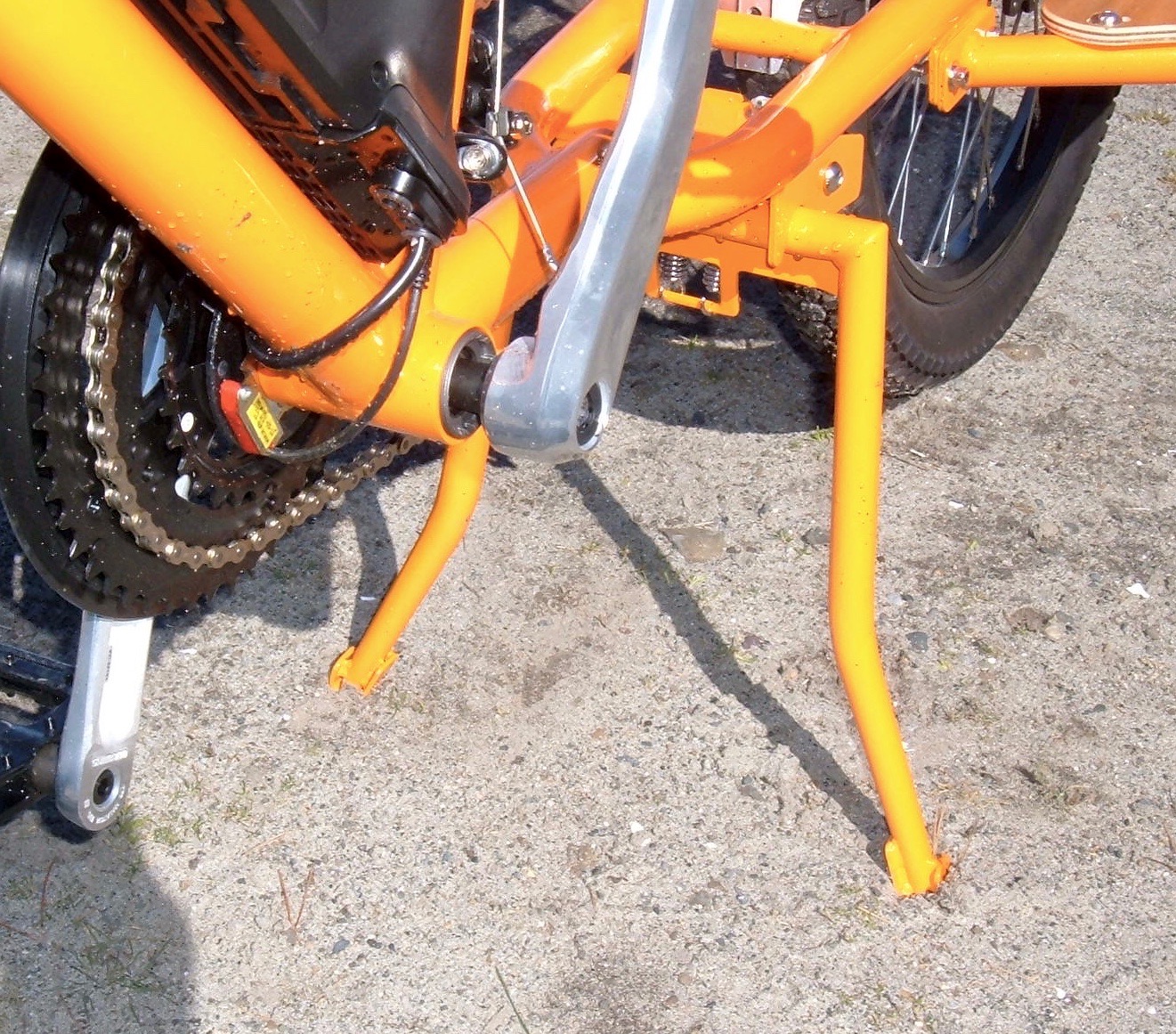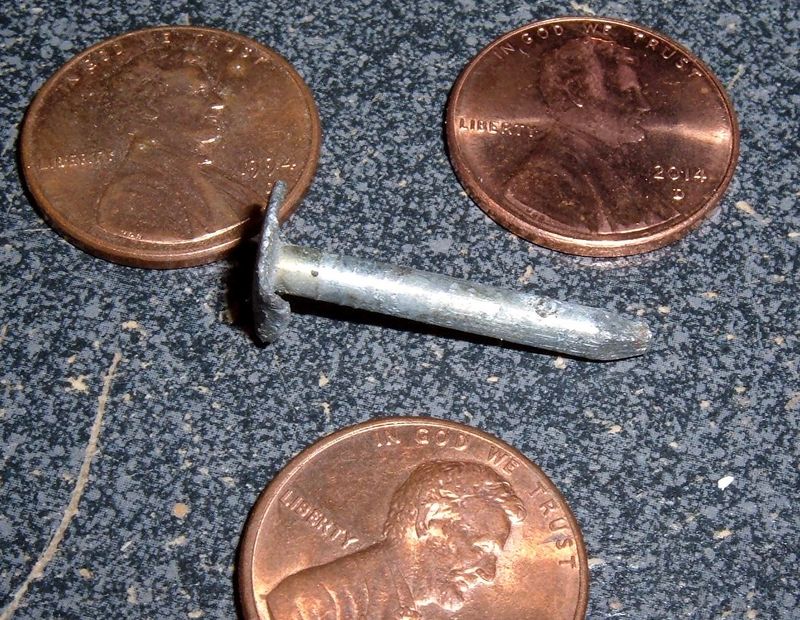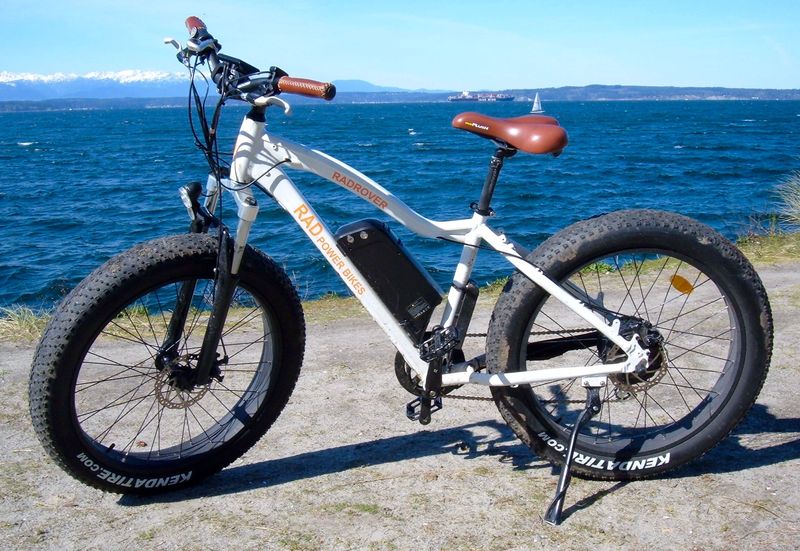It’s not a secret that I like electric bikes. I’ve built my own, because I have no interest in what $4k+ commercial bikes offer, and I haven’t found a cheaper commercial bike that I felt was reasonable for what it cost.
Until now.
I took a few hours on a beautiful Thursday to check out Rad Power’s new location in Ballard, and to check out both the Rad Wagon and the Rad Rover. Here’s what I found!
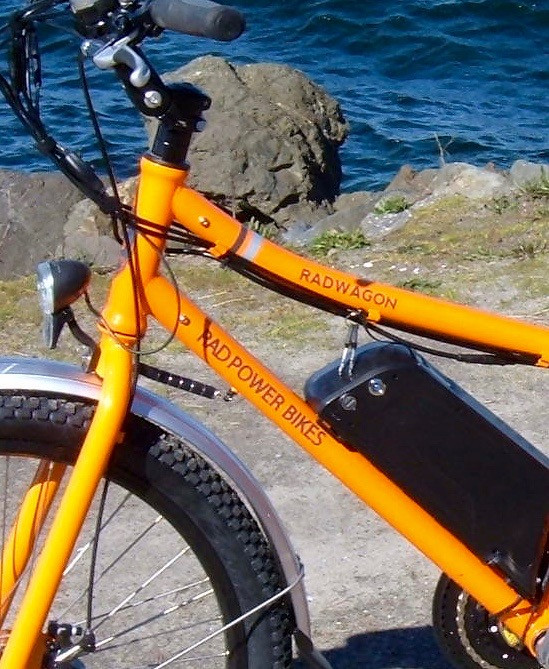
Keep reading for lots of details, and lots of great lakefront photos of a beautiful bike!
The Rad Wagon
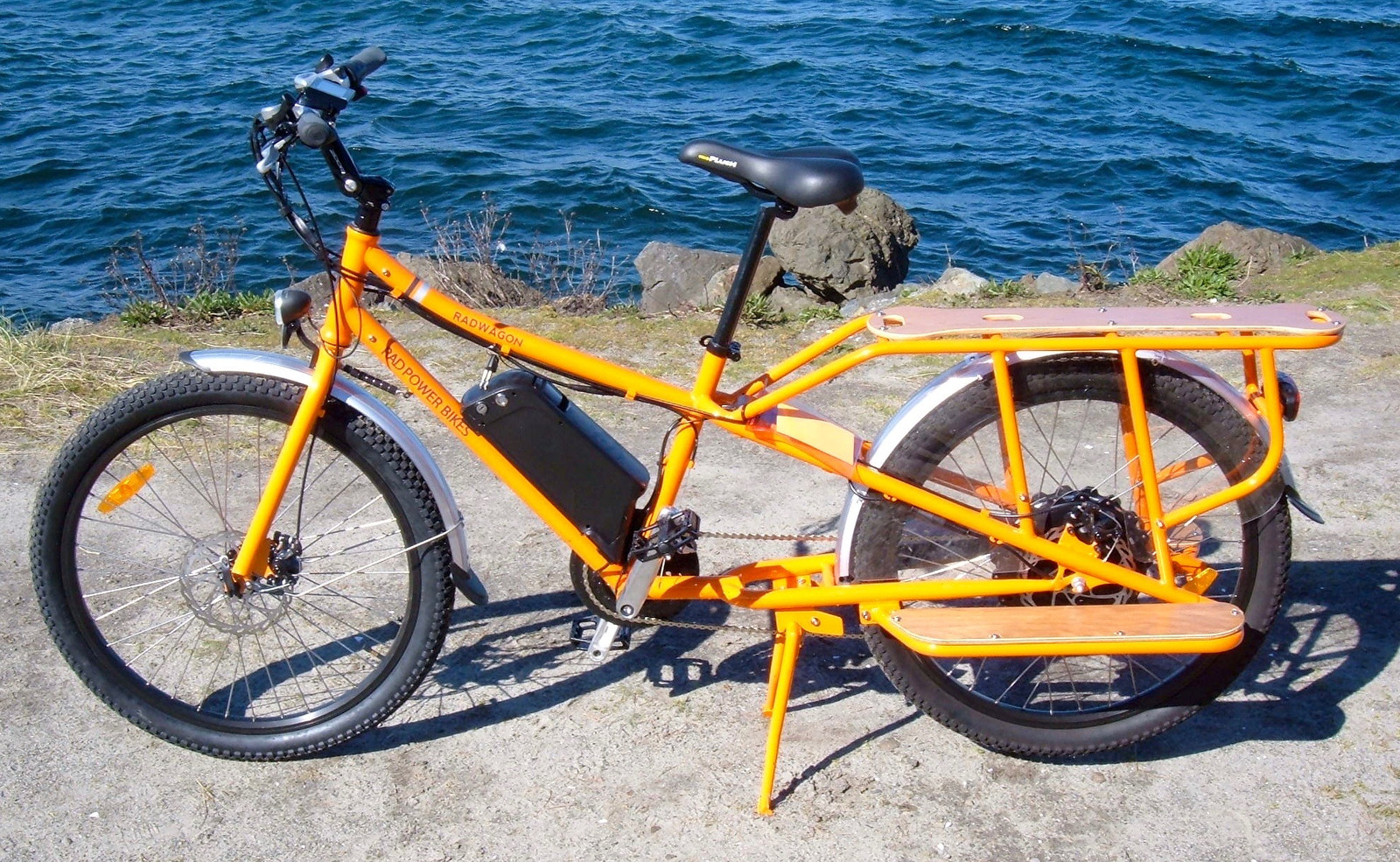
The 2016 Rad Wagon is a steel frame, long tail, 750W electric cargo bike. It’s designed to carry up to 350 lbs including rider, and it has a cargo mount on the rear for your various hauling needs (bags, kids, pizzas, etc). There’s a 550+ watt-hour battery pack mounted on the frame, and a nice LCD dashboard. The bike rolls on 26x2.3 wheels, and has a full range 21 speed drivetrain in addition to the motor. It even comes from the factory with lights and fenders!
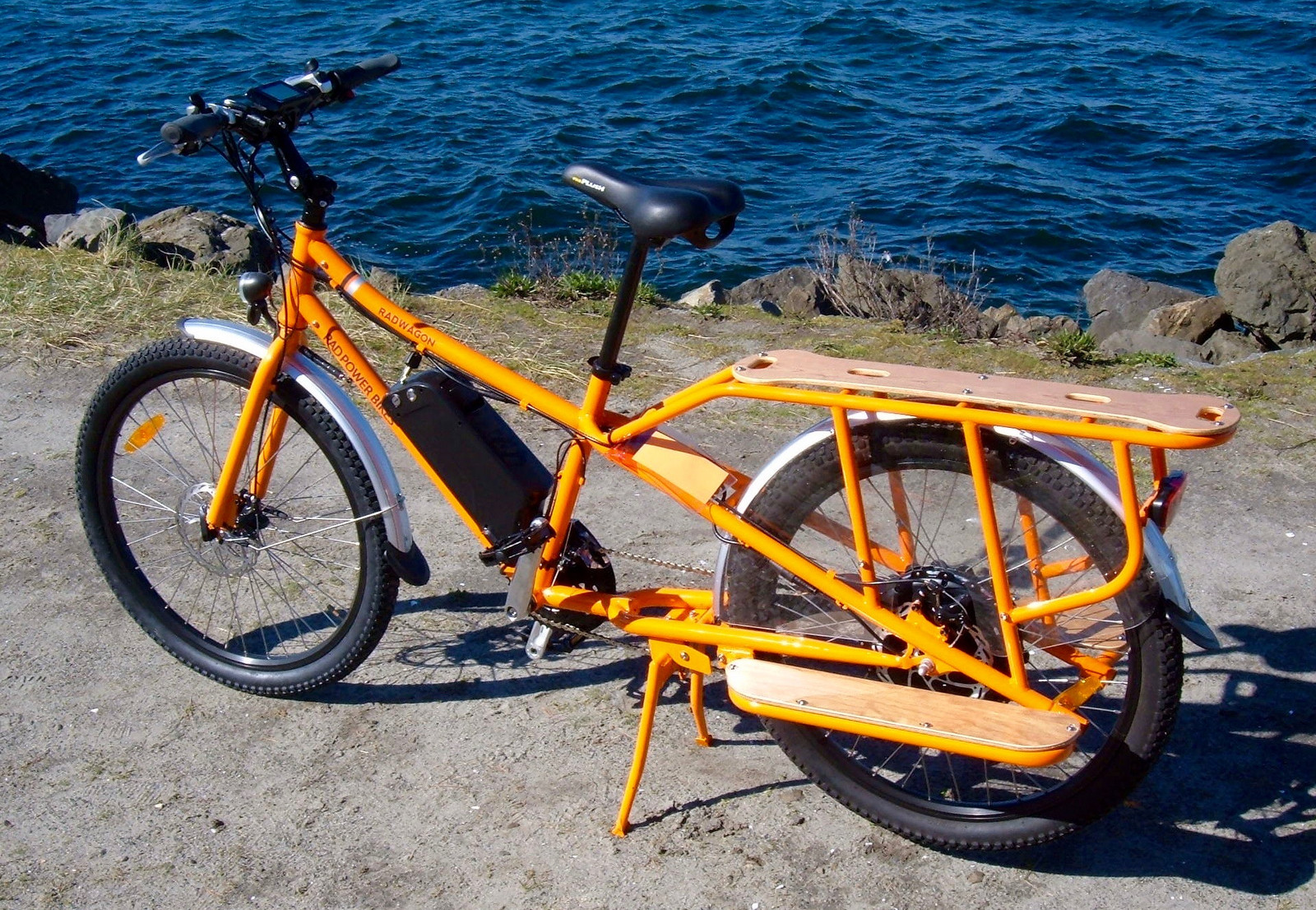
There’s everything you need, and nothing you don’t. This bike notably does not have Bluetooth integration with your smartphone (though it does have USB chargers for devices). It doesn’t even have an App. It doesn’t promise insane charging speeds - it just has a huge battery. It doesn’t fold. It doesn’t have an expensive suspension setup, instead relying on the tires for suspension and the steel for vibration damping. And it doesn’t come with an absurd price tag.
Instead, it comes with a very well thought out set of features that are actually useful if you want to ride a cargo bike daily.
Features
The Rad Wagon comes with a few items I’ve never seen on other bikes (except the Rad Rover), and some standard gizmos you want on a cargo bike.
Shifters
The Shimano shifters are a bit unusual. Instead of using twist grip or normal index shifters, the front chainring is shifted by moving a lever (it’s indexed). The rear selection is done by pushing a lever to go to a larger sprocket and pushing a button to go smaller (up a gear). It’s different, but it works really quite well. With the motor, it’s rare that you’ll use anything but the largest front chainring - you only need to drop down when either climbing a very steep hill, or if the battery dies (but with over half a kilowatt hour of capacity, that’s not going to be easy to do).
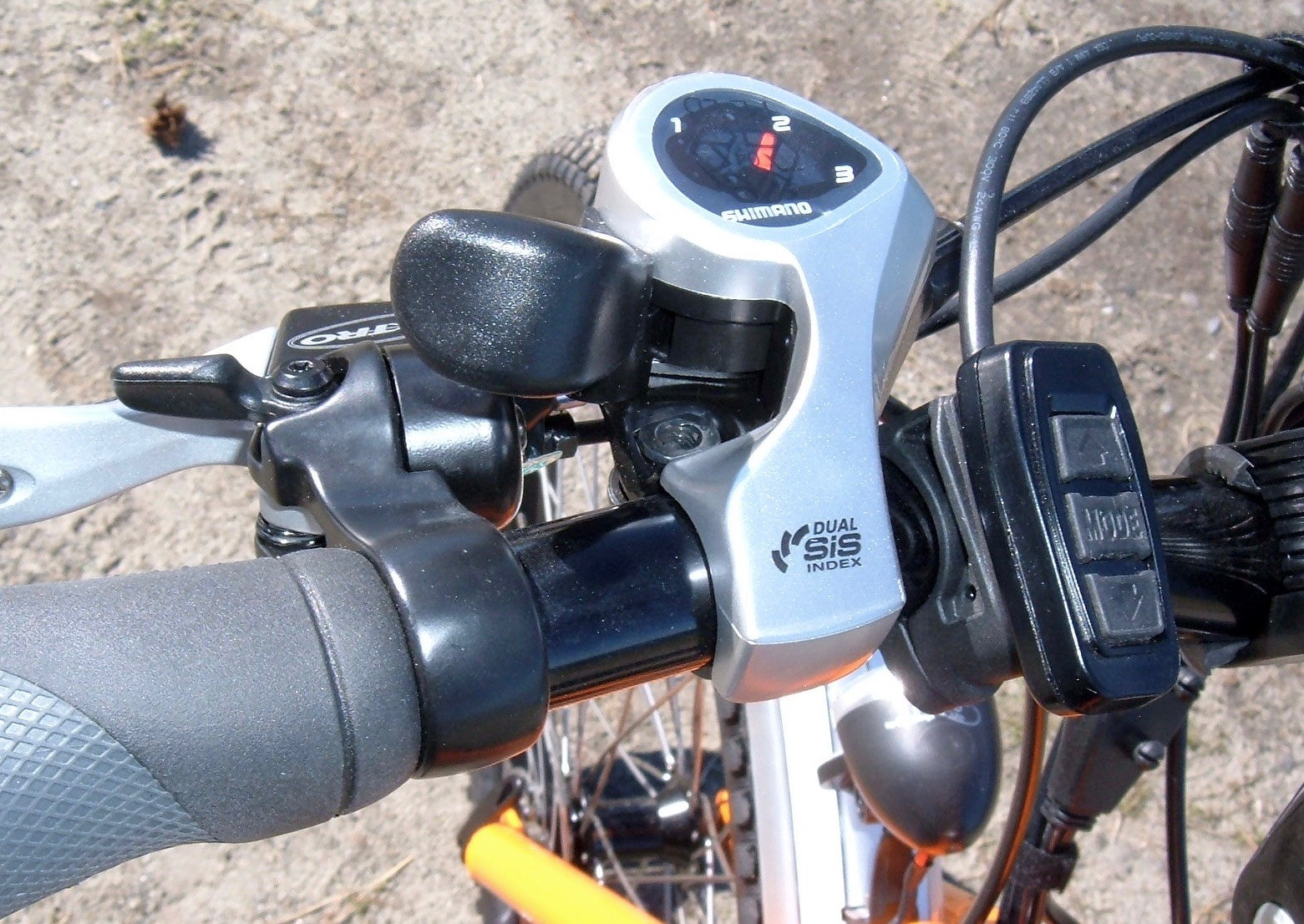
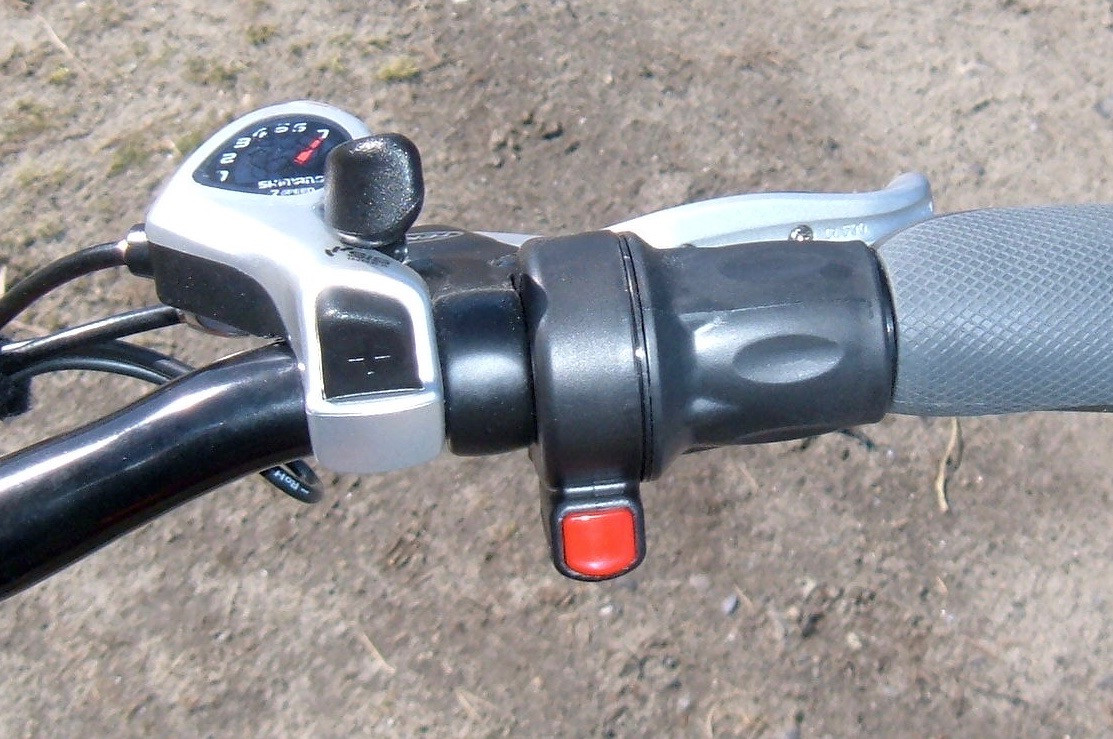
Center Stand
Cargo bikes usually come with center stands instead of kick stands. This bike is no exception. A center stand keeps the bike standing upright, tripoding on one wheel (usually the rear) and the two center stand points of contact. This means that the bike is fully upright as you load the bike, and there’s less risk of the bike tipping over as can happen if you load up bags in the wrong order with a kickstand. The center stand is wide, and only barely lifts the front wheel off the ground - so it’s easy to get the bike onto the center stand, and it’s easy to roll the bike forward and off the center stand.
On softer ground, the center stand will dig in slightly, and hold the bike up while the wheels support the bulk of the weight. It’s really very stable.
There’s no “landing gear deploy” lever like some of the XtraCycles have, but it really doesn’t seem to be needed. The center stand is well positioned to kick down and support the bike from the seat position.
One quirk of center stands is that on many bikes (my commuter included), the front wheel will flop sideways when it’s hanging off the ground. Not on this bike, because it has a…
Centering Spring (Deflopilator)
The front wheel has a small centering spring (also known as a “deflopilator”) to keep it lined up when the bike is on the center stand. It doesn’t interfere with riding at all, but it keeps the wheel from turning and the handlebars from smacking you while you’re loading things up.
In addition, it prevents the wheel from turning around 180 degrees and straining the cables for the throttle and console.
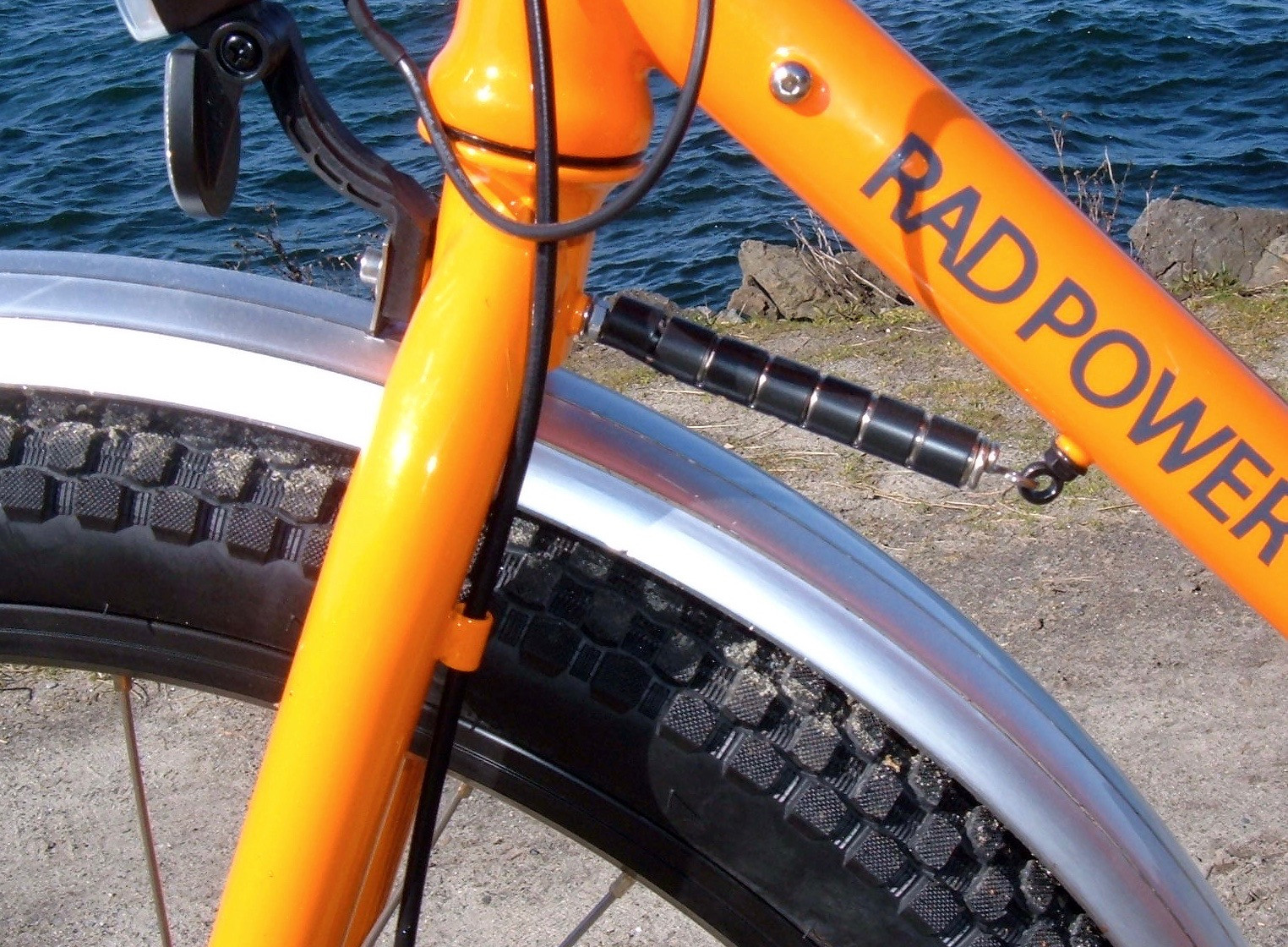
I found a bit of a rise and stuck the bike on it. The spring works exactly as advertised, and keeps everything straight as can be!
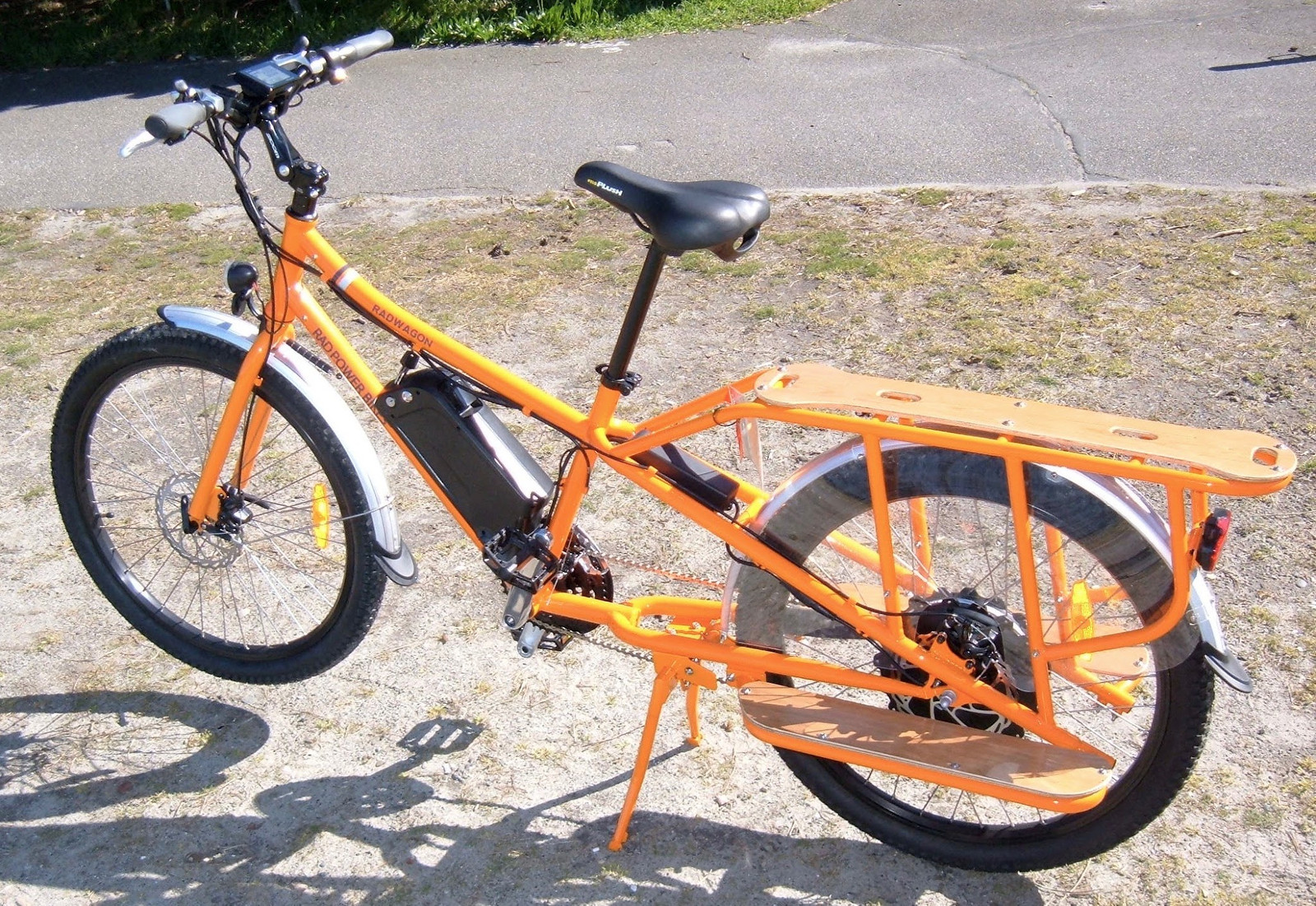
Seat Handle
There’s no getting around the fact that cargo bikes are long, though the Rad Wagon is shorter than some other cargo bikes on the market. Sometimes, lifting the rear and swinging it around is the easiest way to park it where you want it. The Rad Wagon has a handle integrated into the seat to make this much more comfortable for you! It’s thing like this - the little touches - that show me the people who built this really do understand how it’s going to be used.
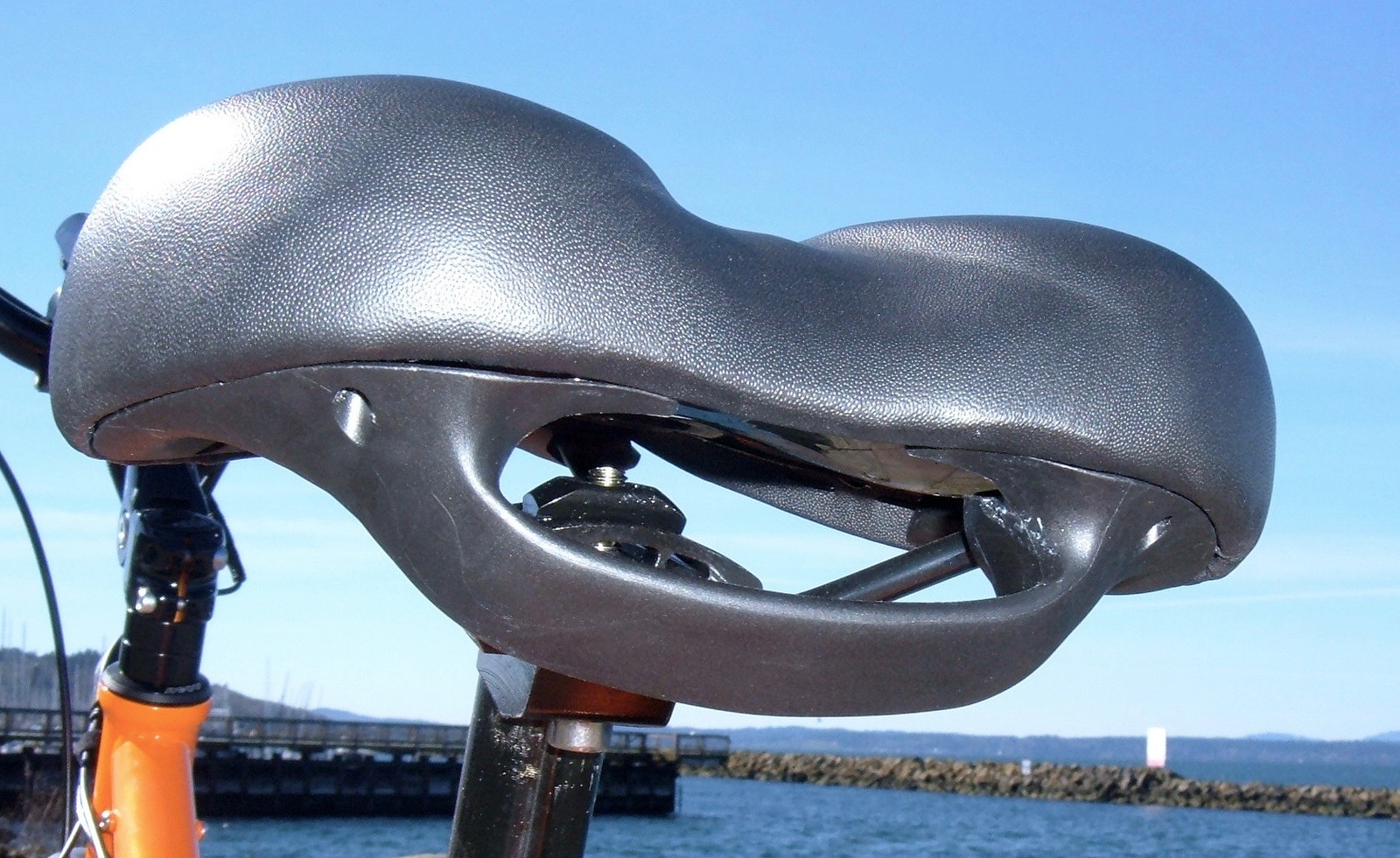
Integrated Bell
“On your left. On your left! ON YOUR LEFT!” *ding ding ding*
To my never ending annoyance, lots of people on trails wear headphones, and I think they keep the volume up pretty high. Human voices just don’t punch through whatever it is they’re listening to.
The sharp impulse of a high pitched bell, on the other hand, gets their attention.
Built into the left brake lever is exactly such a bell! It’s a small bell with a little lever, and it’s loud! It’s perfectly positioned, and it works exactly as one would hope. I’ve never seen a bell like this before, but I want one! I had a few chances to use it, and it very effectively gets people’s attention. I’m pretty sure this is a recent addition, as I’ve not seen it in other reviews.
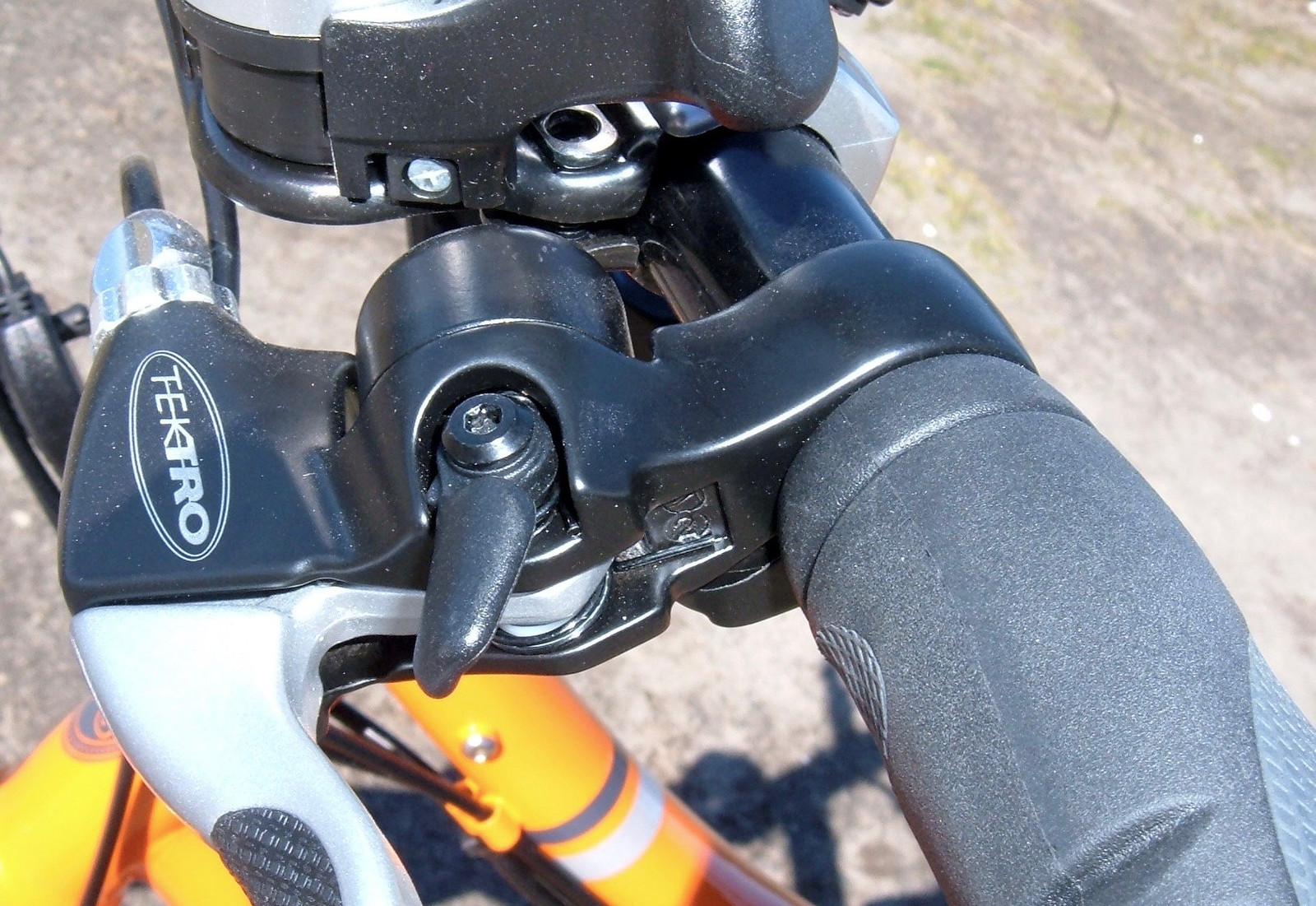
11 Gauge Spokes
Broken spokes suck. I’ve certainly broken my share, and have destroyed a few rear wheels from not noticing them in time.
Most bikes use 14 gauge spokes. Most electric bikes use 12 gauge spokes (smaller number, larger diameter spokes - logical, of course). Rad Power turned it up (down?) to 11. They use 11 gauge, stainless steel spokes on the wheels. They’re massive.
Short of taking a pair of bolt cutters to a spoke, I have no idea how you’ll break one. This wheel is stoutly built - which is exactly what you want with a big motor on a heavy bike.
Seriously. Look at these things! They’re gigantic!
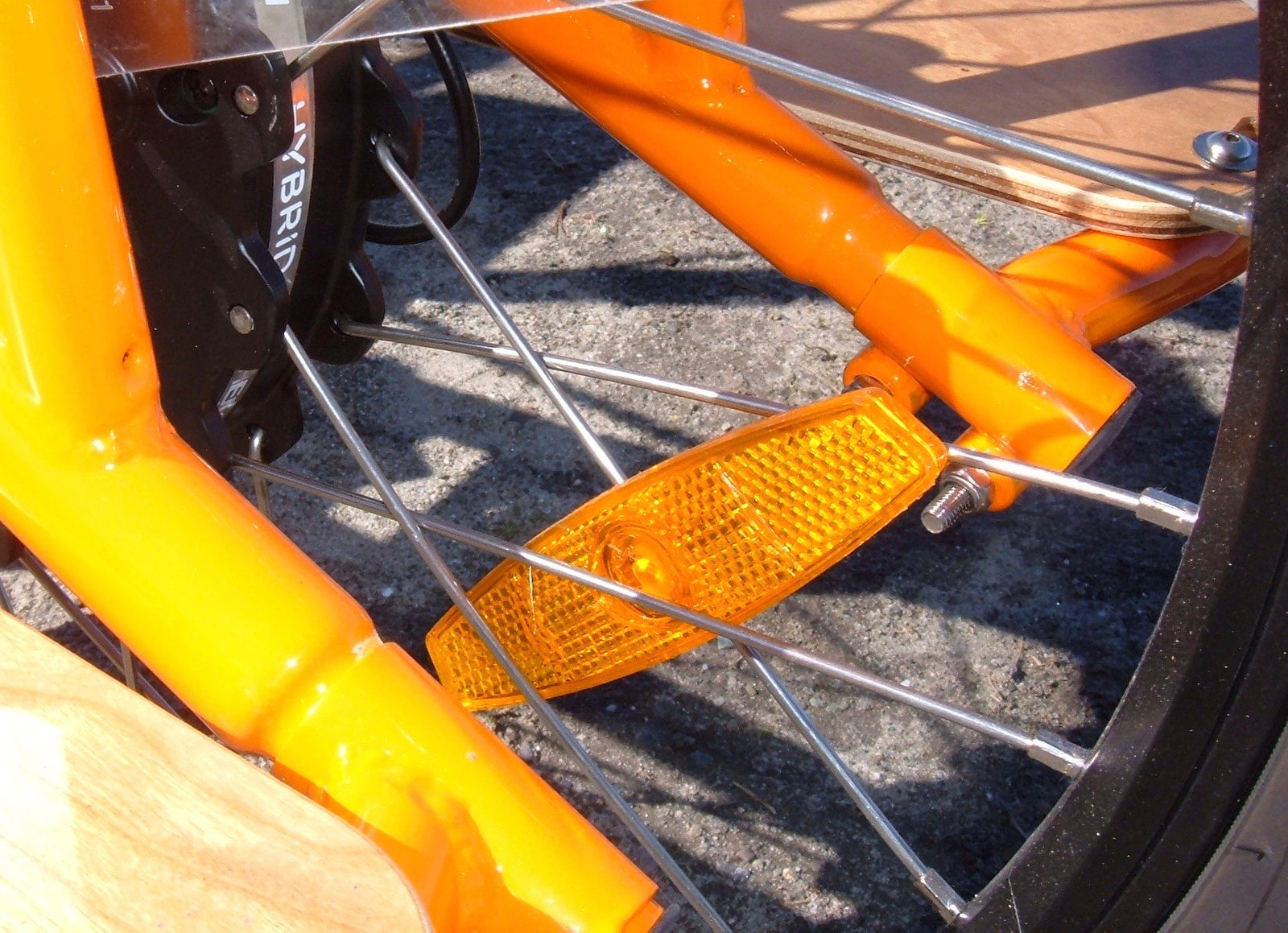
Lights
This shouldn’t excite me as much as it does, but the sad fact is that an awful lot of electric bikes on the market today don’t come with lights.
Why? I have no idea. But I do think that a bike without lights is just a toy.
The Rad Wagon comes with both a front light and a rear light. The front light is pack powered, and the rear light runs off batteries. They last a long while, but it’s something to remember when you get off the bike.
How good is it? I actually don’t know. As you can tell from the photos, I had a rare sunny day in Seattle, so I have zero clue how good this light is at night.
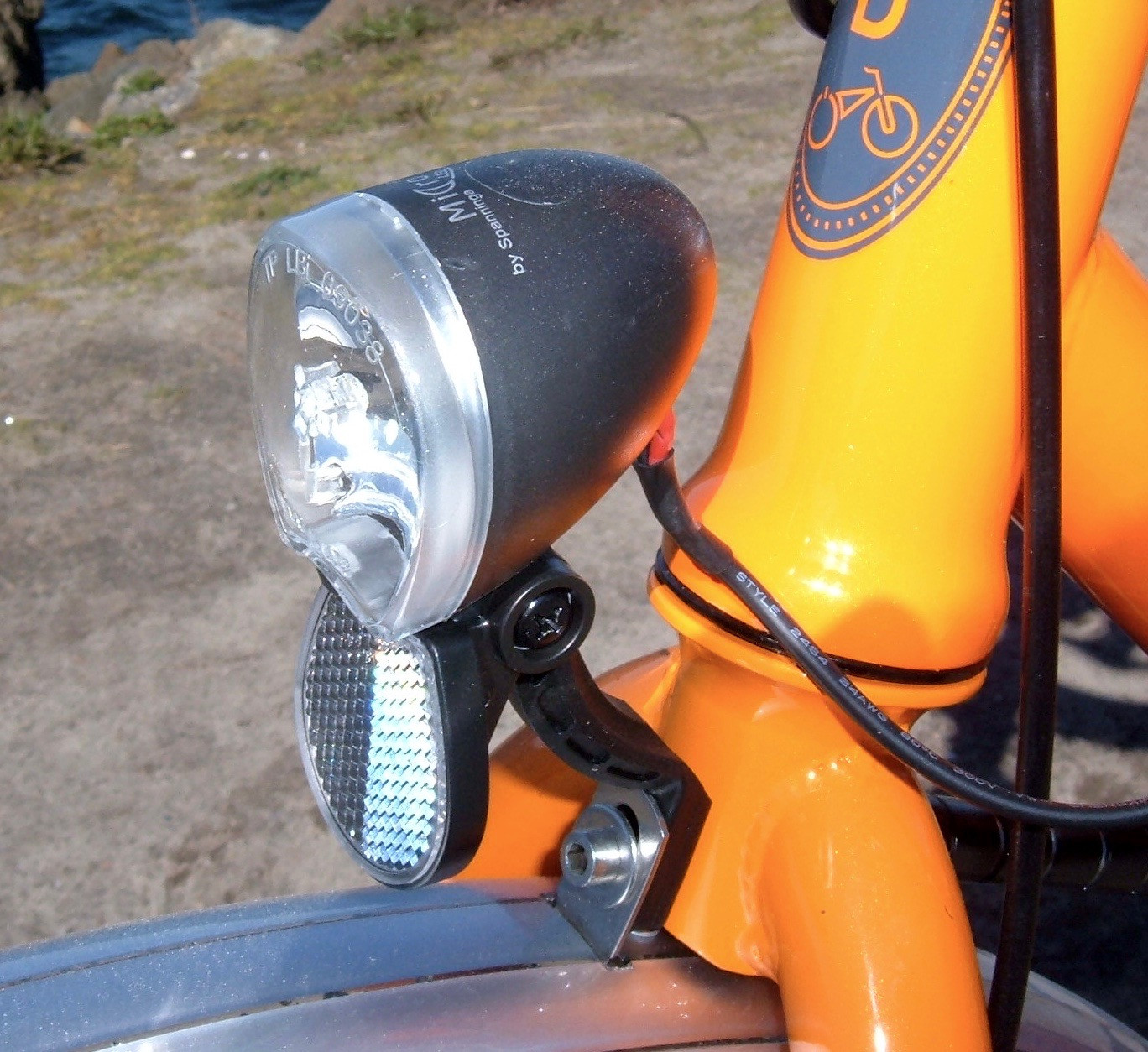
Also, those running boards are beautiful.
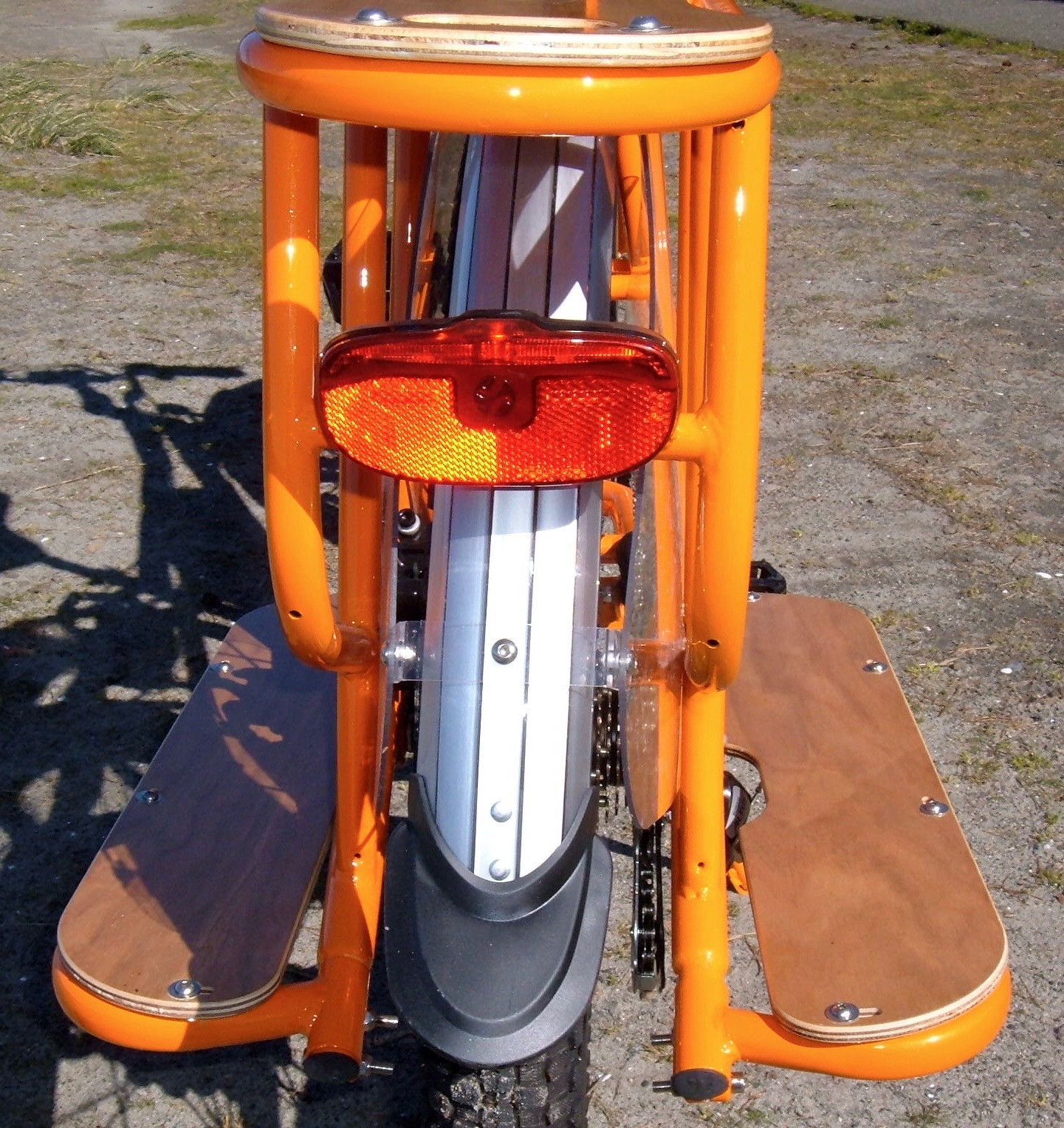
Fenders
This is a bike company based in Seattle - a city known for it’s rain. And a cargo bike is the type of bike that one might ride year round, in all weather.
So, of course, it comes with fenders. Very, very good fenders, based on the puddles I encountered!
In addition to the normal, quite competent fenders, there’s a separate, clear set of “cargo shields” (or “passenger leg shields”). This helps keep the splash from the rear wheel off either your cargo, or your kid’s legs. Not having ridden it from back there, I can’t comment as to how well they work, but they’re well positioned above the footboards, and I suspect they make a big difference, or they wouldn’t be on this bike.
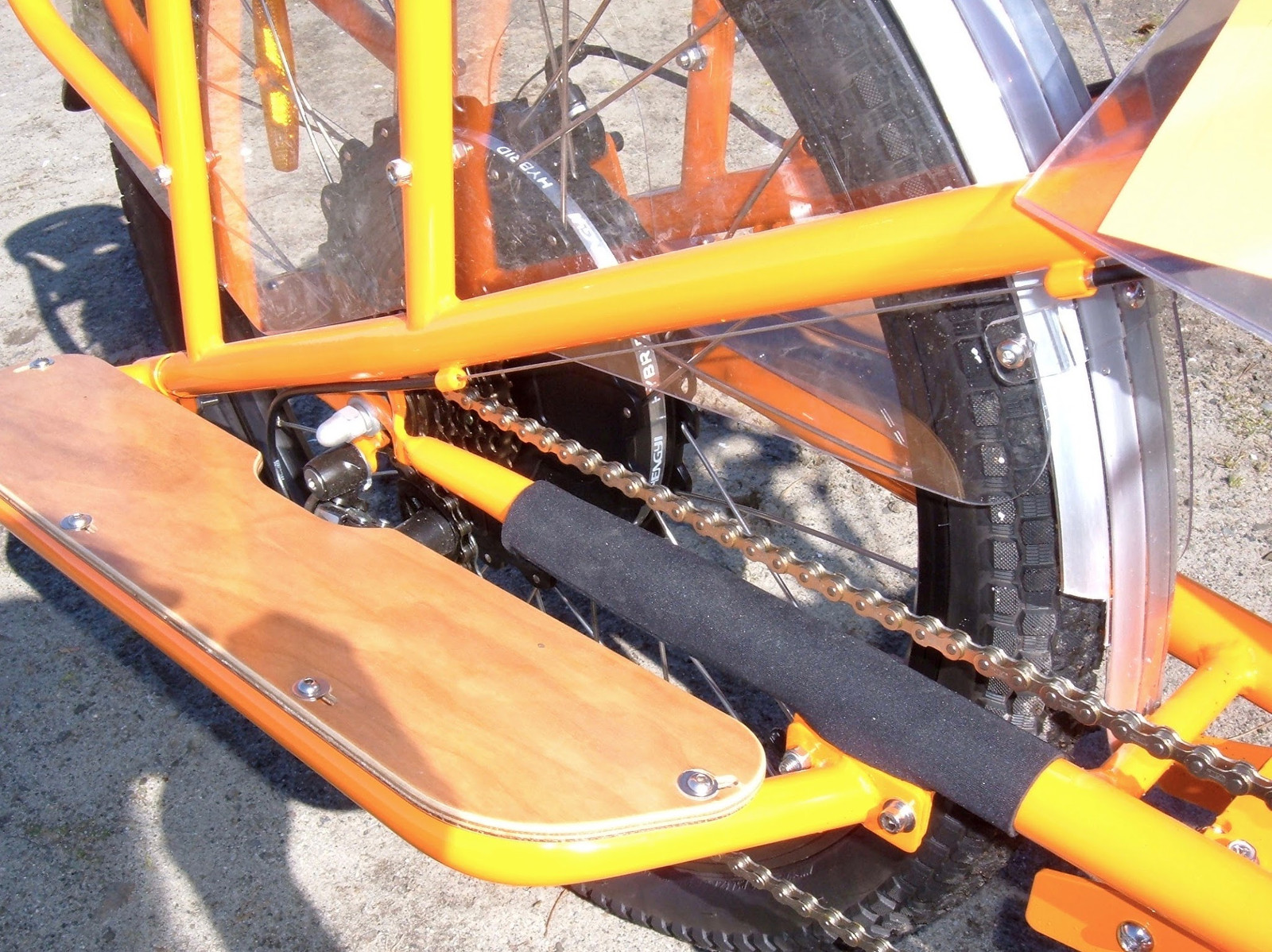
Seat
Seats involve a lot of personal preference, and there’s no “perfect seat” for everyone.
The stock seat is a well padded Velo Plush of some variety or other (I suspect it’s at least somewhat custom, based on the handle formed into the underside).
I prefer harder, narrower seats, so I’d probably replace it, but it’s acceptable as a basic seat, and I had no complaints at all in the 5 miles or so I took it. For typical around town cargo bike use, it’s just fine.
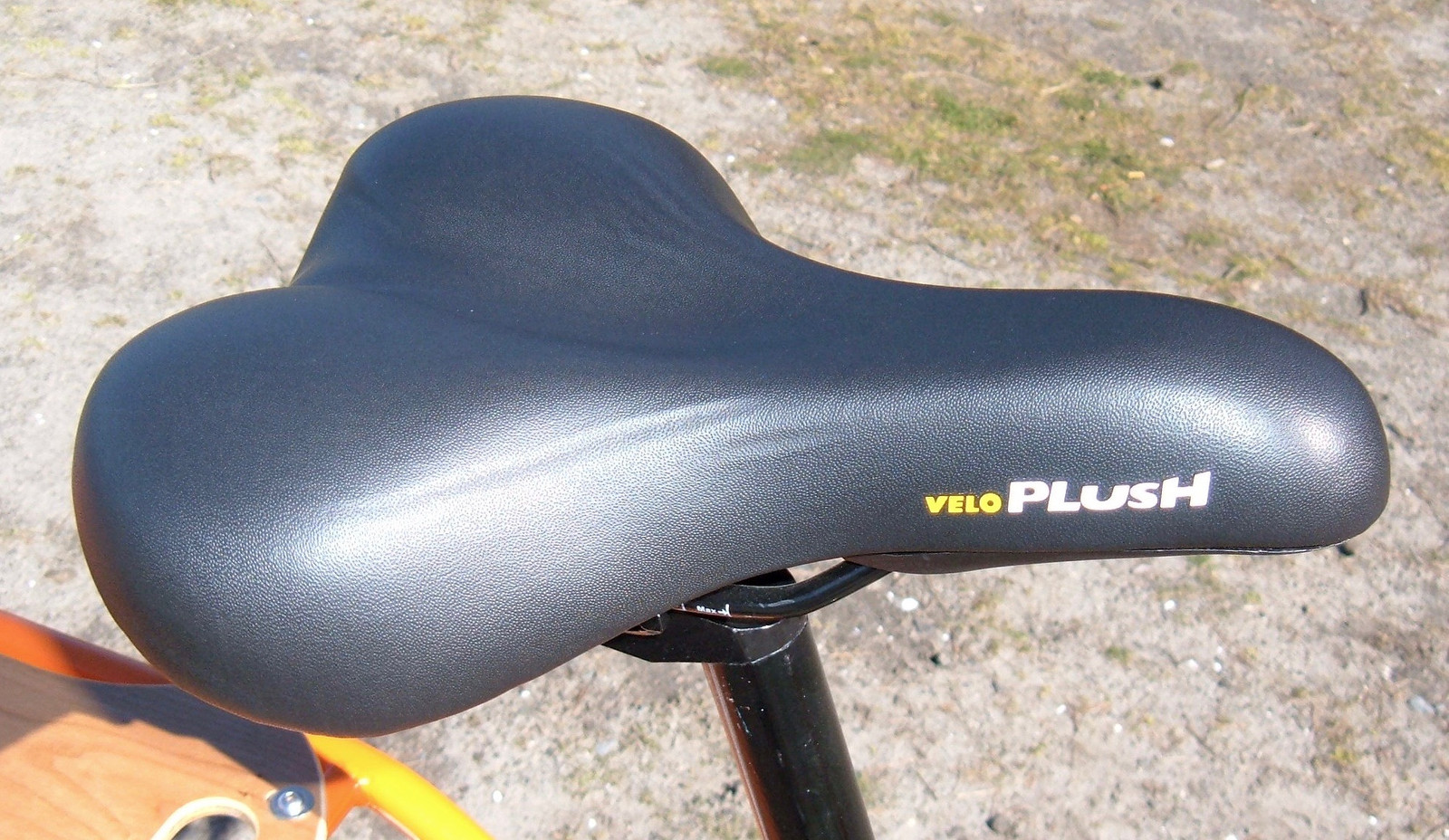
Riding
Alright. Enough about the features. You want to know how it rides - is it any good?
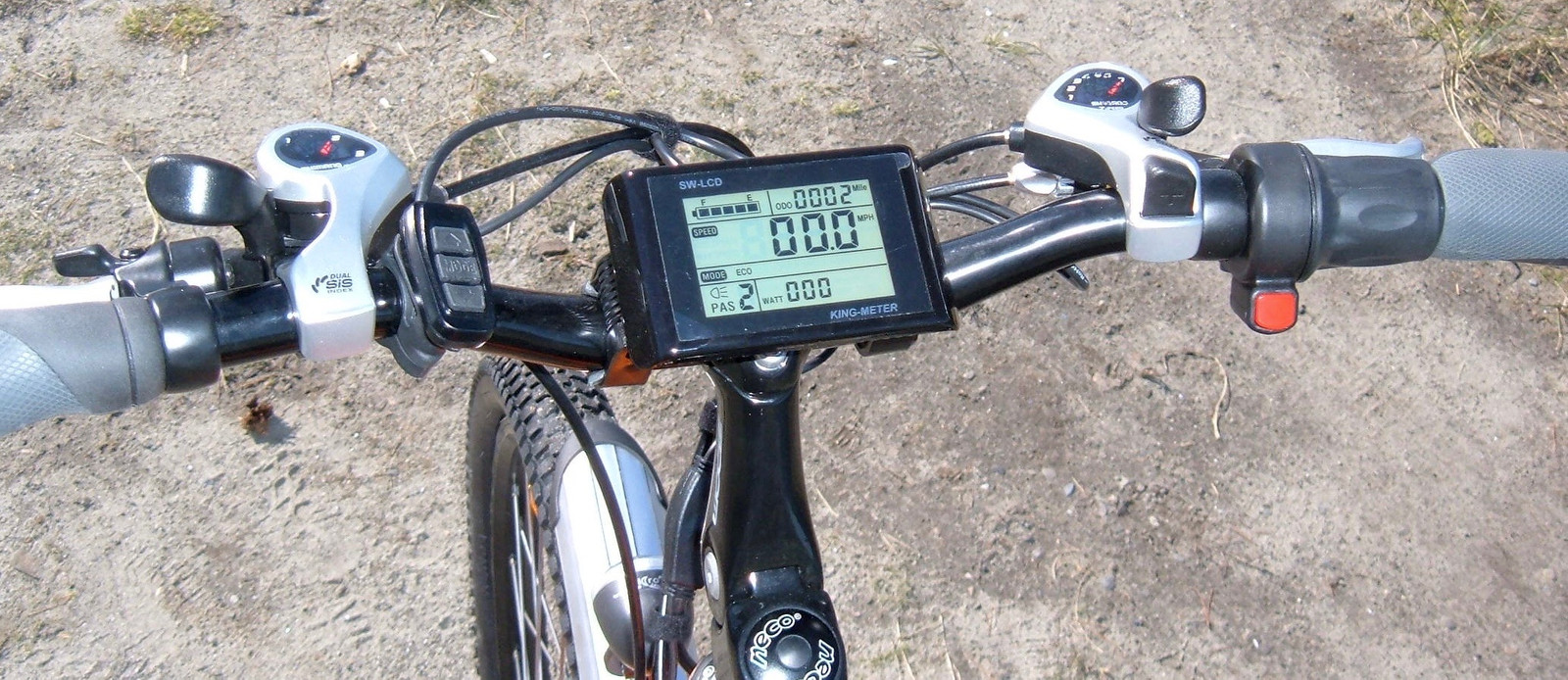
I took the bike on a 5 mile test ride. It involved a blend of city streets, bike trails, some loose gravel, up a steep set of switchbacks with awful pavement, and around some residential neighborhoods, with a bit of doubling back to climb some more hills - just because I could. With a few side detours missing, this is what I did (clockwise). If you’re test riding one out of Ballard, I’d suggest this route - it really shows the bike off in a set of common environments, and that hill climbing out of Golden Gardens is brutal!
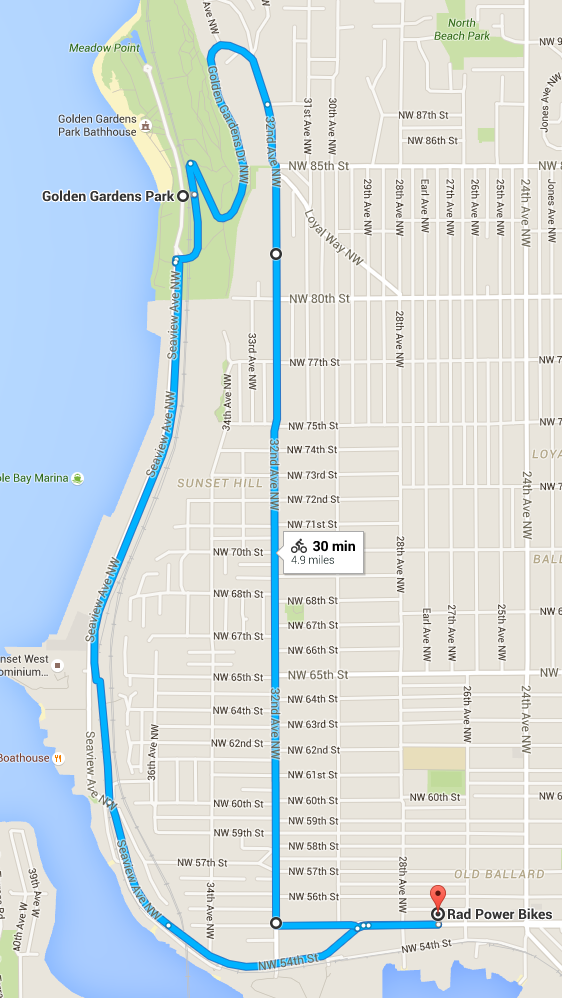
Vertically, I went from 16’ to 308’ (in quite the hurry) and came back down. So, some pretty good climbing at a ~250 lb total load, and some steep residential street descents to test the brakes out.
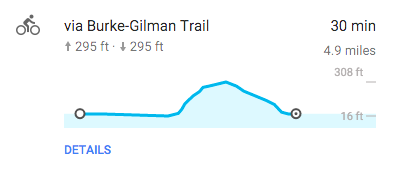
This is a sweet riding bike! Even though the bike doesn’t have suspension, the tires offer a good amount of shock absorbing, and it’s quite well behaved on cratered street surfaces (I might have gone pothole hunting). The length really tames the bike - it’s a long bike, and it rides like it.
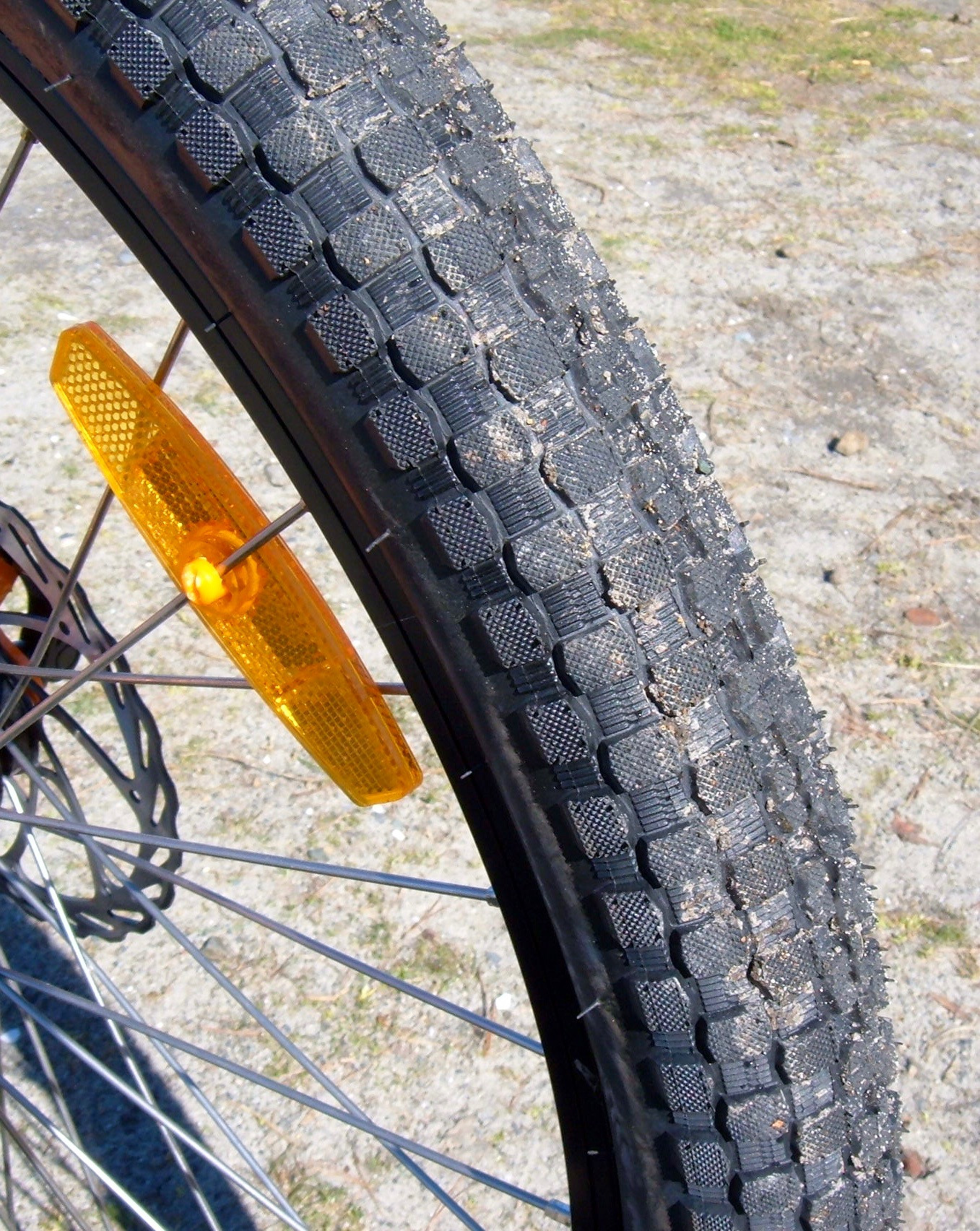
I entirely forgot the steering straightener spring was present. It doesn’t seem to have any impact on the bike at all when riding - or if it does, it blends smoothly into the overall handling.
The bike is very stable when rolling. I don’t know the details of the geometry, but whoever designed it did a great job. It’s exactly what one would want for a cargo bike with kids and groceries on it. I spent a while trying to make it act up by finding the worst path through the road (Seattle has some fairly awful chunks of road), and it just wouldn’t misbehave. Your kids may not appreciate Pothole Lane, but the Rad Wagon is not going to dump them off.
Going up a loose gravel slope, the bike behaved just fine. It’s not going to tackle rough terrain like the Rad Rover, but it’s perfectly competent on any road or trail conditions you’re likely to take a cargo bike on. I wouldn’t want to ride it through a muddy field (the tires aren’t wide enough for that, especially if heavy), but it will handle poor roads or crushed gravel bike trails just fine, and it’ll handle dry dirt trails or loose gravel well enough that I wouldn’t think twice about heading down one, were it the fastest route.
Without Power
A really nice feature on this bike is the full range of gears. It has three front chainrings, and 7 rear sprockets, so even without power, you can find a gear that works.
I spent some time pedaling along a flat trail with no power, and it rides like one would expect. It’s a heavy bike, but it’s quite possible to move along without the motor.
I also tried to climb hills without power. The gearing is low enough to do it, but there’s no real point in this. It’s an electric cargo bike with a huge battery. If you do run the battery out, you’ll be able to get home, but it would certainly be a better idea to pedal on the flats so you have power for the hills.
With Power
Let’s be clear: This is an electric cargo bike. It’s designed to be ridden with the motor running! And what a motor it is!
With the 750W direct drive motor engaged, this bike really scoots along right up to the 20mph legal limit! The direct drive motor doesn’t have quite as much torque off the line as the Rad Rover, but it has plenty of grunt for hills, and also has regenerative braking during descents - which, for a loaded cargo bike, is nice.
If the motor makes any noise, it’s buried in the tire noise. I simply couldn’t hear it.
I found that riding with the pedal assist in level 1 or 2, and using the throttle for additional speed or hill climbing worked well. You can also ride it as a pure throttle electric bike if you’d prefer.
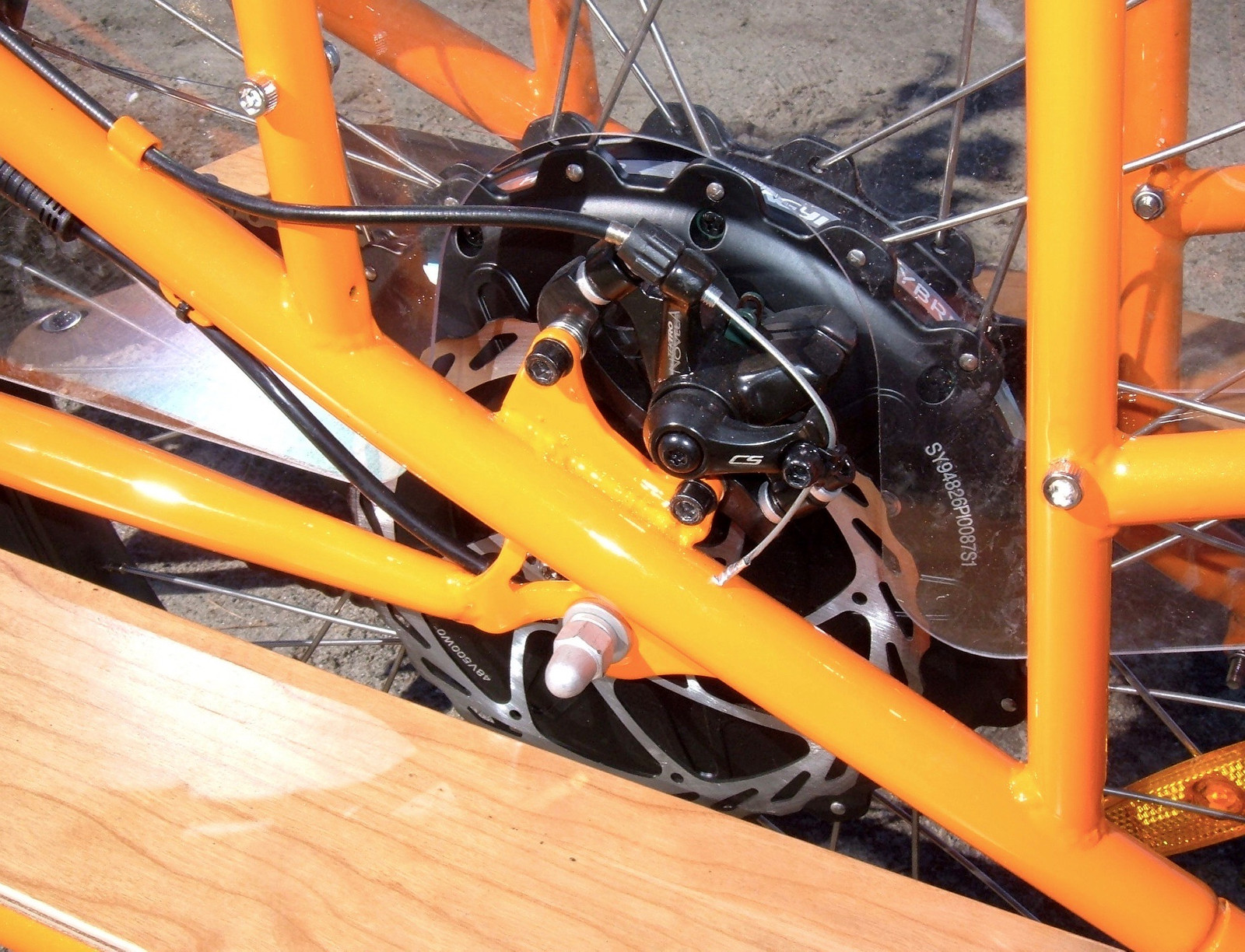
Hills
A common reason people consider electric bikes is to deal with hills. So, of course, I took it up the steepest hills I could find in the area. It did a great job! If the bike is heavily loaded (two kids, a bunch of groceries, etc), you’ll have to downshift and help it some - it’s not a motorcycle. You’ll be zipping right up the hill, though. A “5mph” effort without the motor will net 11-13mph with the motor at full output - and this makes a huge difference.
There are two ways to climb hills. The first is to turn the pedal assist up and just pedal at whatever is a comfortable level for you. Pick the gear you want, and the bike will do everything it can to get you up the hill faster. The second is to leave the pedal assist lower and use the throttle. Either way results in 750W (1hp) of motor pushing you up the hill.
One thing you’ll notice is that the battery gauge drops when climbing hills, then bounces back when you’re on the flats again. This is the expected behavior of a battery pack (voltage drop during high current draw), and isn’t anything to worry about.
Brakes
One criticism I’ve seen of this bike is that it doesn’t use hydraulic brakes. It uses cable actuated disc brakes.
This is quite true. It does use cable actuated brakes. And, the brake feel isn’t amazing. They’re a bit heavy, and there’s basically no feedback in the levers.
That said - they work. They do their job in slowing the bike down quickly, and since this bike is a bit heavier in the rear than most bikes, using both is important.
I asked about this, and learned that while the feel of hydraulic brakes is better, the cost to benefit ratio simply wasn’t there. Hydraulic brakes add a lot of cost, and really didn’t make a difference in stopping performance. So, cable actuated they are.
If they really bother you, and you’re willing to give up that awesome bell, you could swap a hydraulic set on the front easily enough. But I think they’re just fine.
Cadence Sensor, Throttle, and Console
The pedal assist mode uses a cadence sensor, but it doesn’t try to be smart. It functions as an on/off switch - if you’re moving the pedals, it puts out power. The power level selected (1-5) determines how much power it puts out, and how fast it will top out on motor power. It works quite well, and it’s easy to understand what the bike is doing. If you want to spin the pedals instead of use the throttle (while not actually contributing power), you can do so. Or you can use a low level of pedal assist and use the throttle.
The cadence sensor is the red unit, tucked up against the frame. It’s pretty well protected by the chainrings, so it shouldn’t be a problem. And, since there’s also a throttle, even if it does have a problem, it doesn’t prevent you from using motor power!
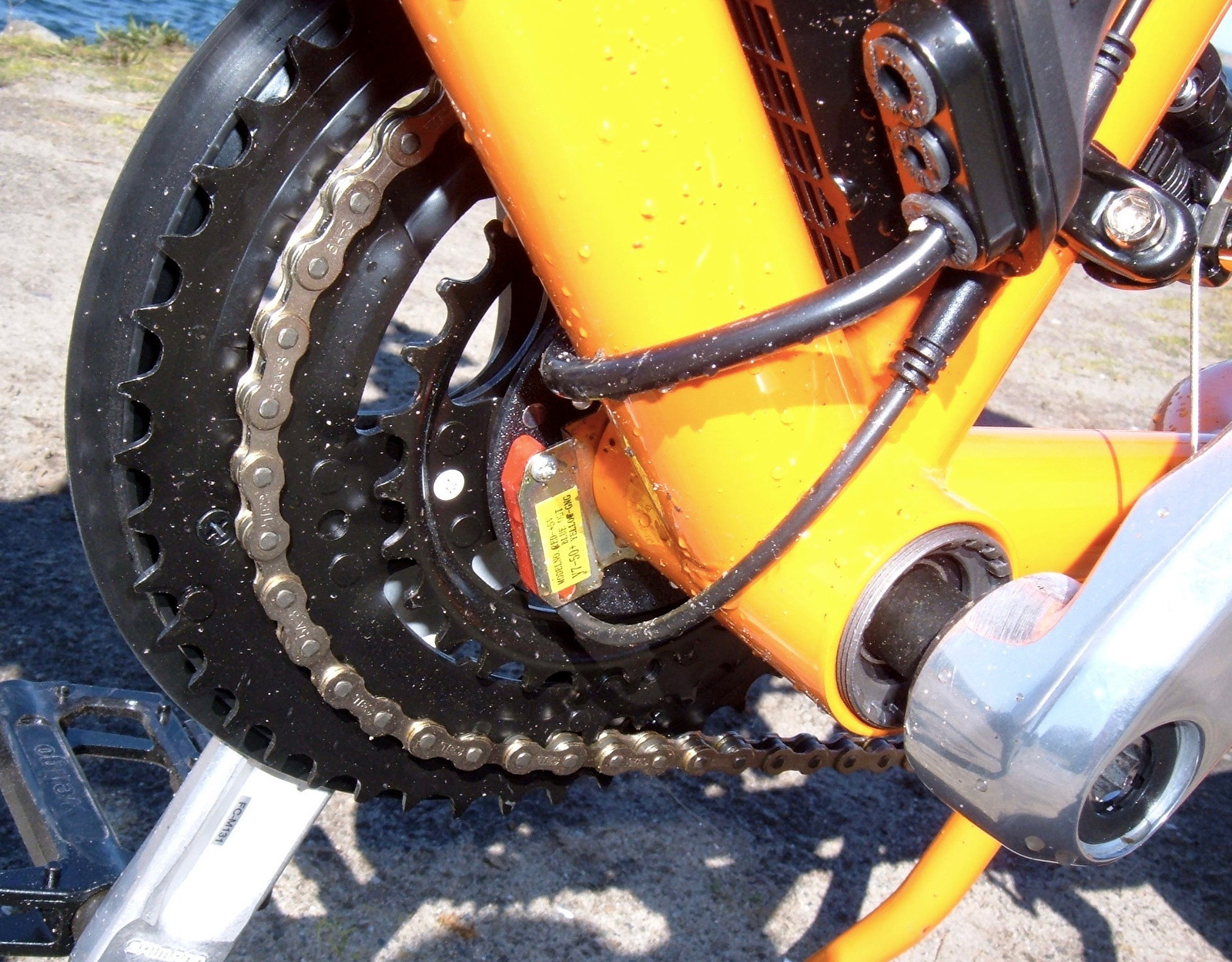
Turning the assist up and down while riding is easy enough using the controls on the left handlebar, though can be a bit of a challenge on really rough roads.
If you’re creeping around a sidewalk or coming up to a bike rack, make sure you turn the assist down. Level 5 will get your attention in a hurry at low speed. Level 1 or 2 is fine, though.
The throttle is a half twist style throttle with a lock out button. The outer edge of the bar is just grip, and the inner part is the throttle. It’s a smooth, light throttle, and there’s no hand stress trying to keep it applied if you want to motor along. If you’d rather not inadvertently request 750W of fury, you can use the red button to disengage the throttle totally. If you turn the throttle off, it doesn’t do anything, but it’s a thumb press away from working.
I’ve not seen the lock out feature before, but if you’re the type of person who rides along with pedal assist only, it’s nice. I think it’s required for some European countries as well.
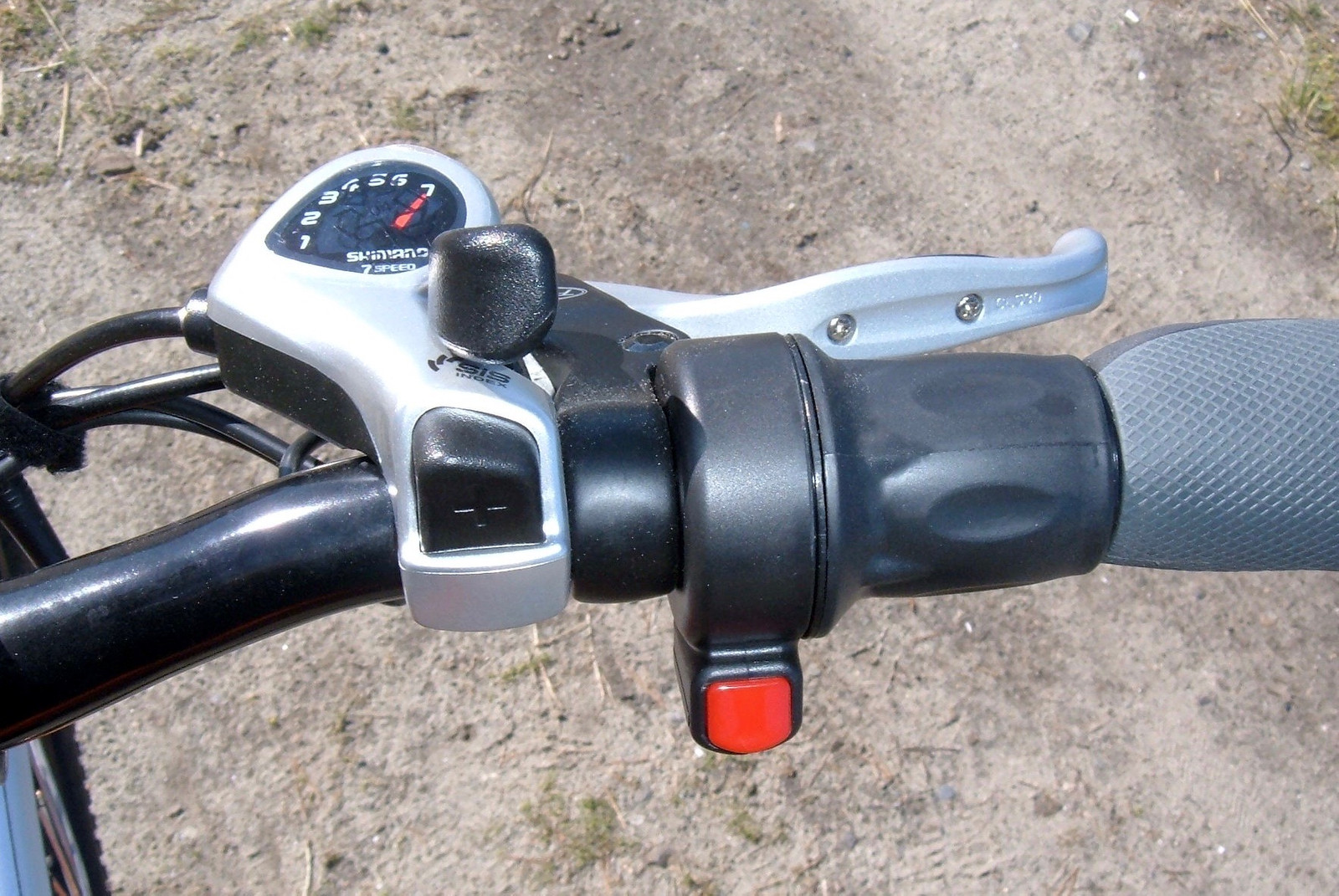
The console. It comes with a full console, instead of just a strip of LEDs like some other bikes have. It shows you how far you’ve ridden, your battery capacity, your current speed, pedal assist mode, and how many watts the motor is helping you out with. Knowing how many watts are going out is helpful for range estimation, should you care to do so - once you know about how many watts of assist you’re using, you can figure out how far you’ll go.
This is a genuinely easy to read unit, even in bright sun. It’s not fancy, but it gets the job done.
Conveniently for Ingress players and other people who like their phones mounted on the handlebars, the controller also has a USB port for charging!
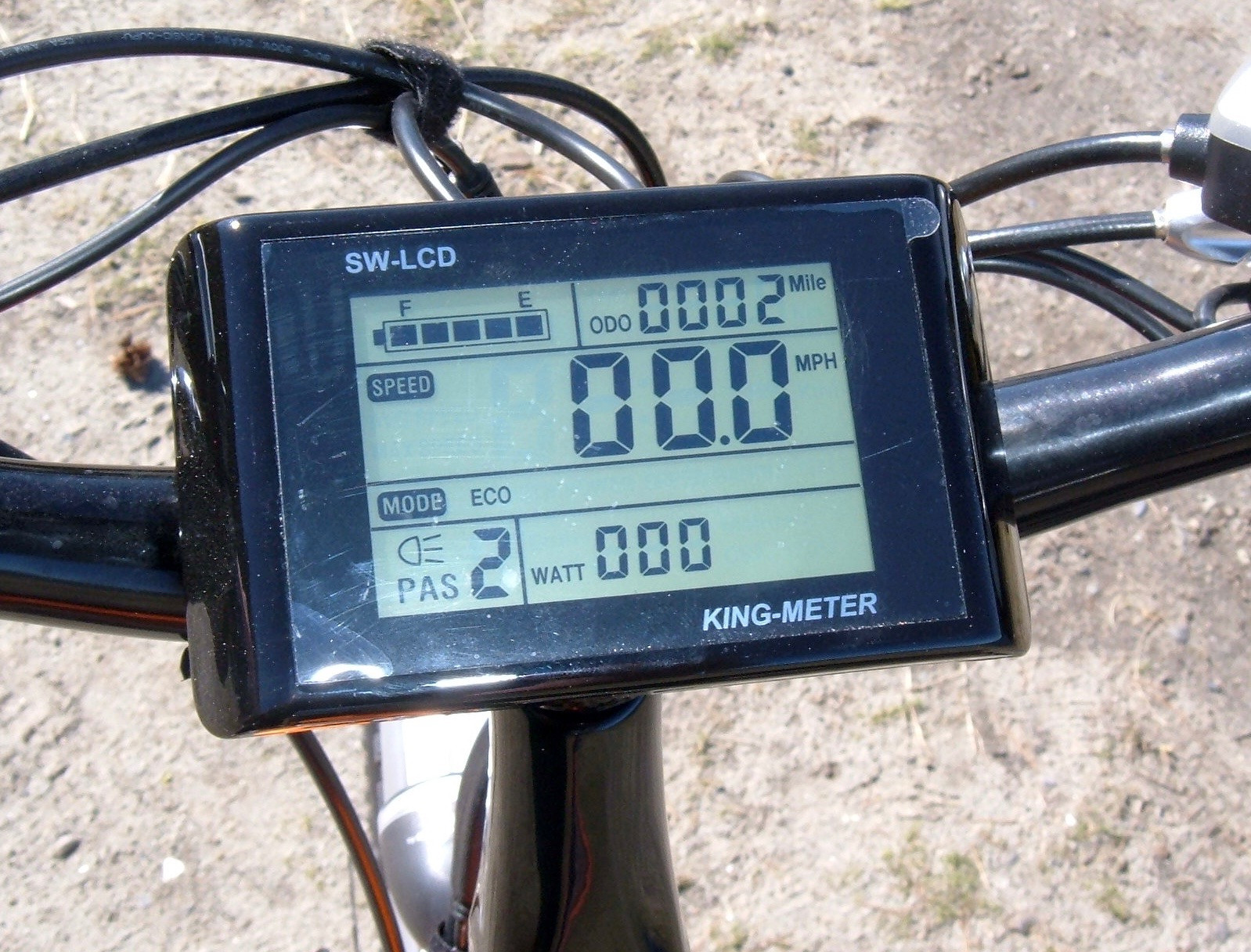
Battery Pack and Charger
The battery pack is a pretty bog standard style for 2016. It’s a 48v, 11.6Ah pack, with just over 550Wh of useful capacity. Most electric bikes, when ridden at 20mph purely on throttle, will consume about 30-35Wh/mi. At the upper end (35Wh/mi), that’s about 16 miles of pure throttle goodness. With a pedal assist, bikes usually consume closer to 15Wh/mi - so around 37 miles. And, of course, if you pedal more and use assist less, the battery will last longer.
Rad Power Bikes claims a range of 15-50 miles, depending on how you ride it. This seems entirely reasonable, and I really appreciate them using sane range numbers for their bike and not making absurd claims.
The battery pack locks onto the bike, and comes off with a lever once you unlock it. If you’re riding in cold conditions, it’s a good idea to bring the pack inside and let it warm up before charging - charging a lithium battery when cold (below freezing) can cause rapid capacity loss.
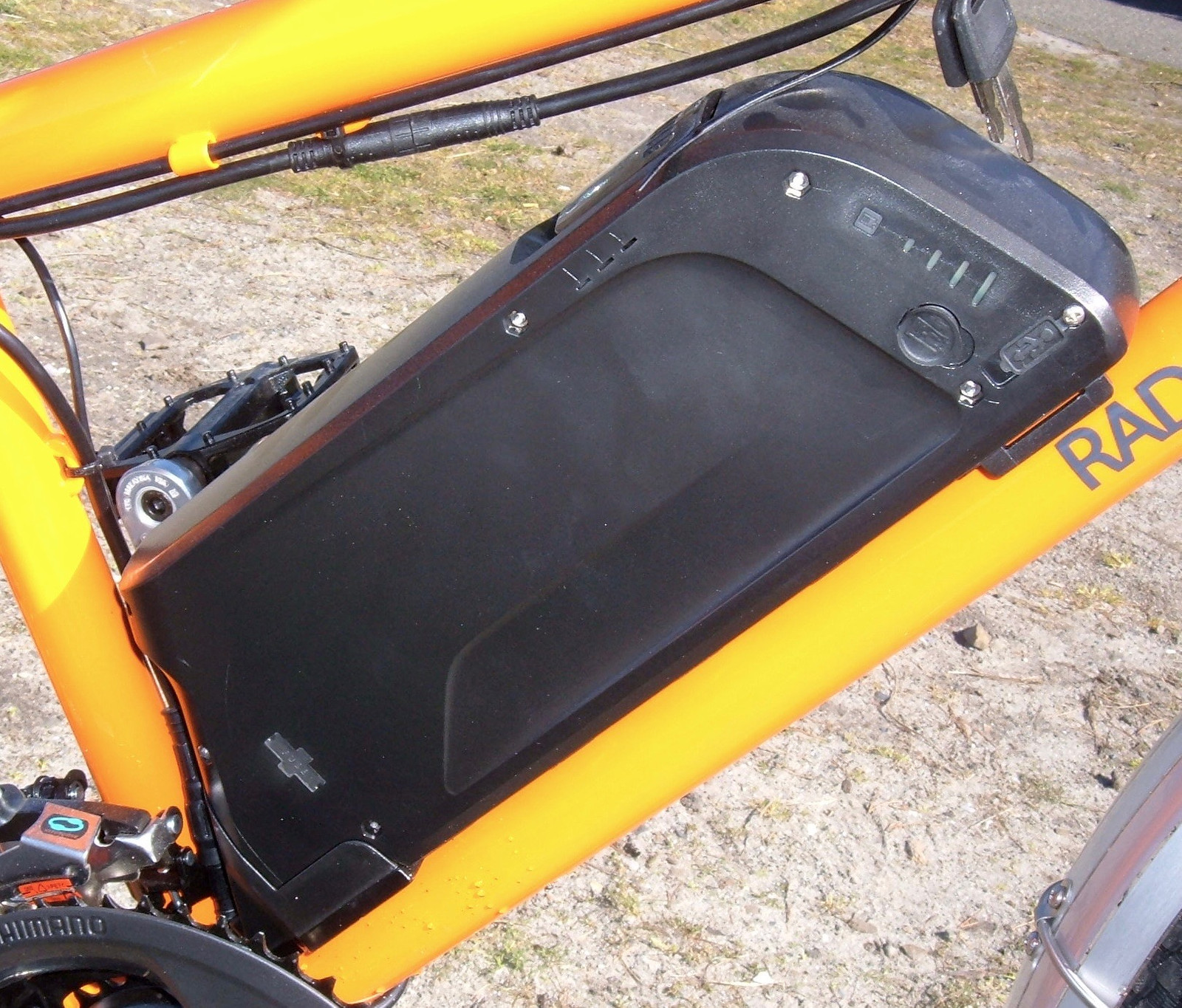
The charger is a 2A charger, which means it will take about 6 hours to charge a fully drained pack. The slower charging rate should help with pack longevity.
If you want to run your phone for months on end, you can take the pack off the bike and use it’s USB port. The iPhone 6S Plus has a 10.5Wh battery. This is a 550Wh pack. That’s over 50 full charges.
Significantly, their choice of a standard pack with nothing exotic means that down the road, it will be easy to find replacements. If Rad Power gets a larger capacity pack in the same form factor, it swaps right in, and since this is a standard enough design, it should be easy to replace the pack in 5-10 years when it gets weak with time and cycles. I have no concerns about their choice of battery, and I really appreciate them not going with anything highly custom or proprietary.
Controller
While I was at the store, I got to see a disassembled controller. And I am impressed!
This a fully potted 12 FET controller, contained in a strong aluminum enclosure that’s sealed with an o-ring. You can see the potting below - it’s the “goop” covering everything. It waterproofs the controller, helps with heat transfer away from components, and keeps things from moving or rattling around (while still allowing enough flex for thermal expansion).
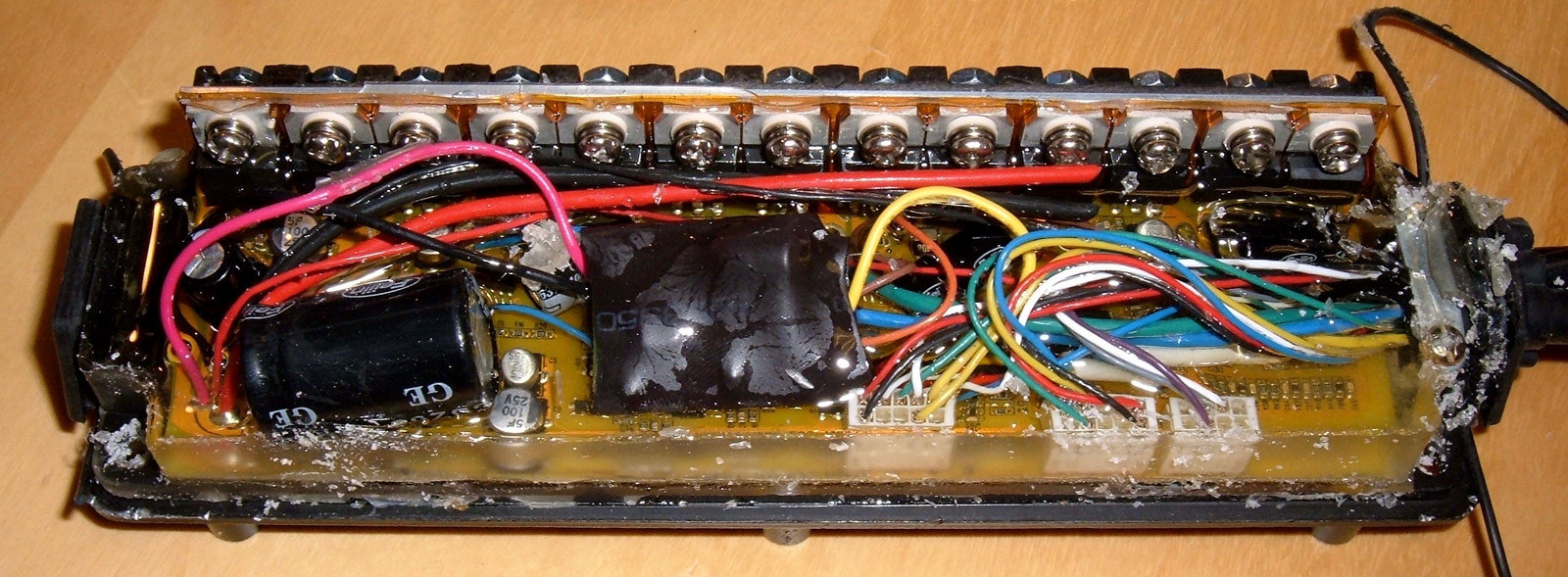
The chassis of the controller has a large aluminum fin that cools the switching transistors - they dump their heat into this, and then transfer that heat into the base and the cover.
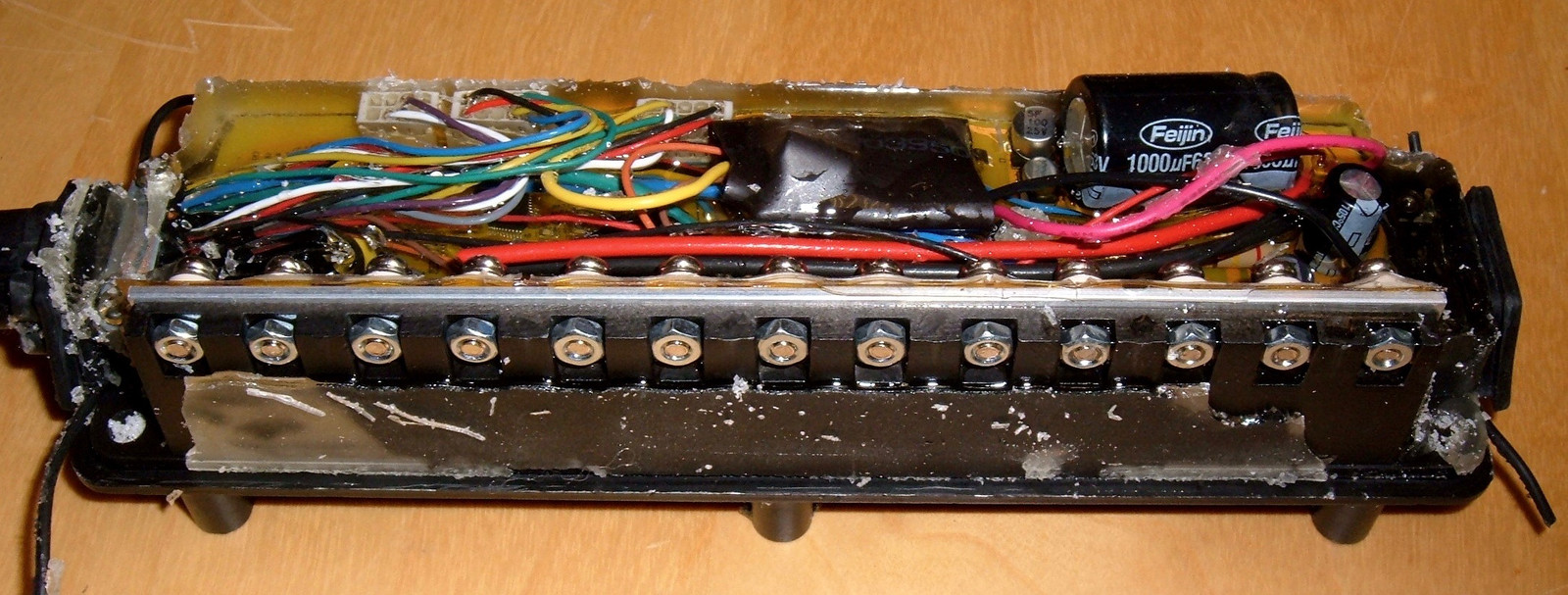
The bottom of the controller casing also has fins for heat dissipation, and is screwed into the bike chassis - which also acts as a heatsink. The cover is a thick aluminum piece as well.
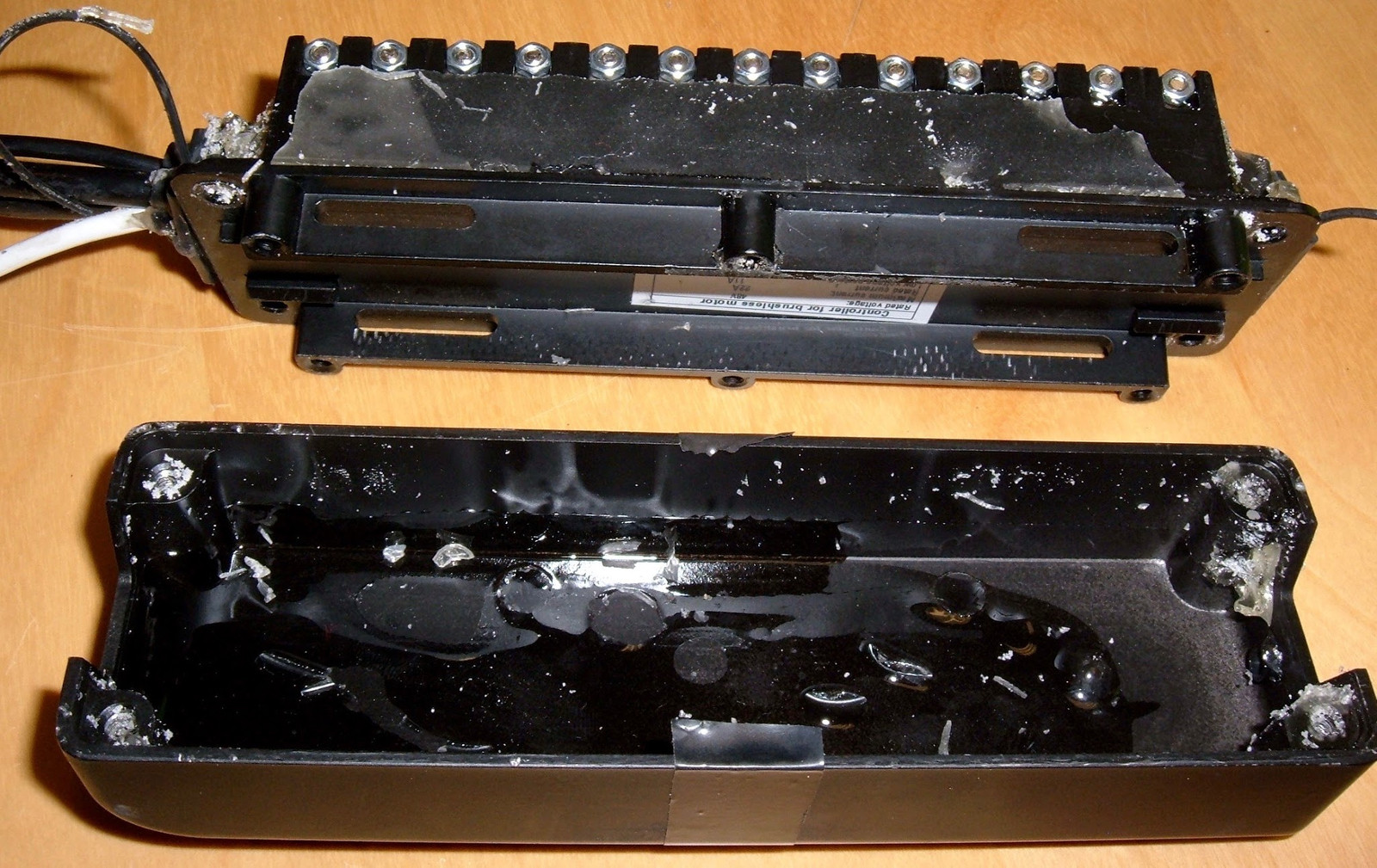
This controller is absolutely overkill for the bike. Most 12 FET controllers on the market are rated for 35A or 40A. On this bike, with a 48v battery, the maximum current it will see at 750W is about 16A. That’s less than half of what someone else might rate a similar controller.
Why do this? Reliability. Running a controller up near rated capacity works - at least for a while, until it doesn’t.
Running this controller at a maximum of 50% of what it can handle, then putting it in a well cooled and waterproof enclosure, means it should last pretty much forever. Even if it’s being ridden daily up hills, this controller has so much spare capacity, and so much cooling, that it’s simply not being worked hard at all.
I can’t ask for anything more. The team building this bike has done an amazing job of spending money where it matters - and this controller should be bulletproof.
Cargo Accessories
The whole point of a cargo bike is to carry stuff on that long tail. Cargo, kids, kids and groceries, pizza - you buy a cargo bike because you want to carry stuff! Rad Power sells some cargo accessories, and their aluminum plate uses standard mounting slots, so you should easily be able to mount other things as well.
This is an example configuration they had in the store - I’d call it the “family car” configuration.
You can fit two kids (one in front with the grab bar, one in the child seat), and a lot of groceries in the bags.
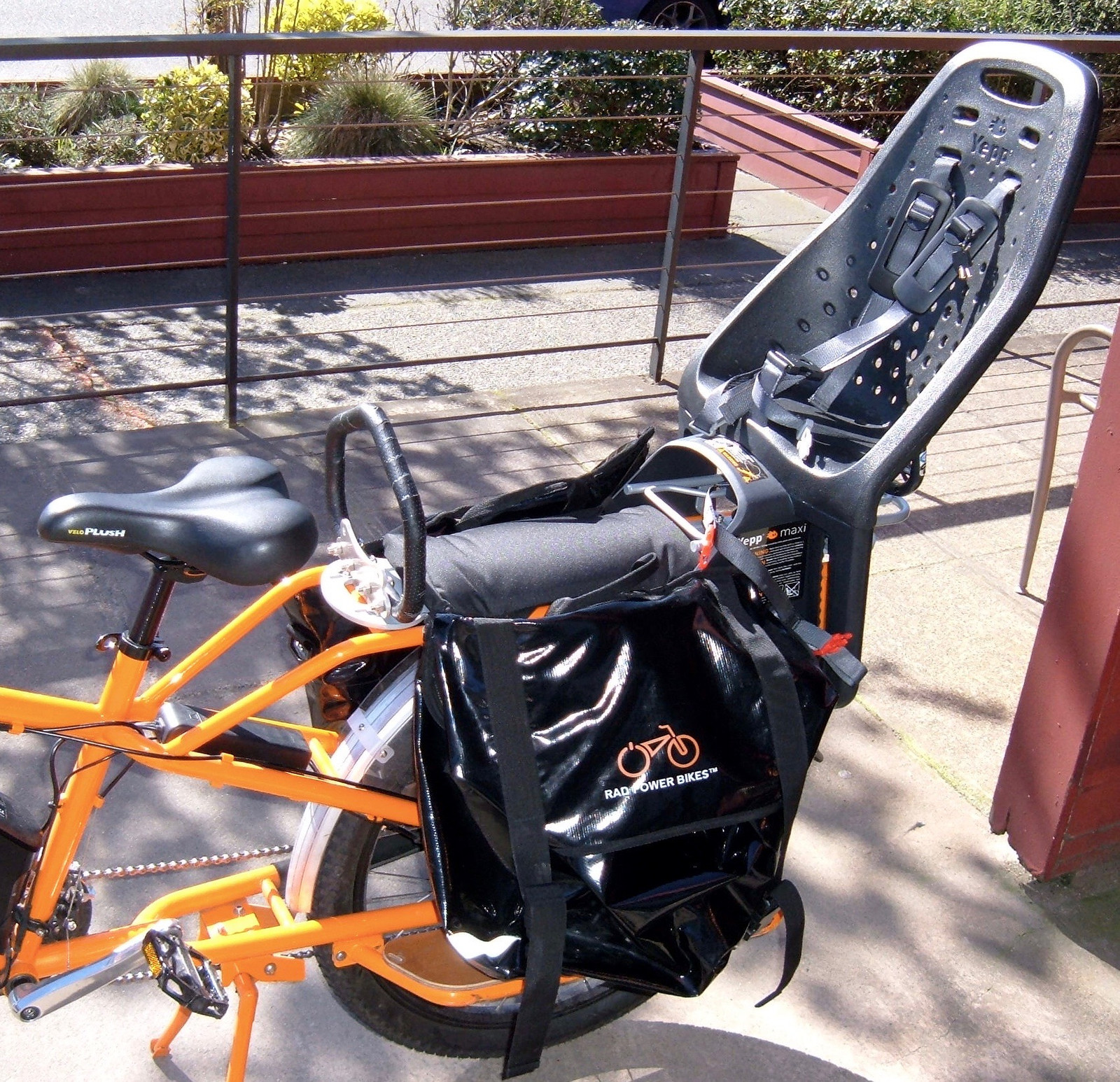
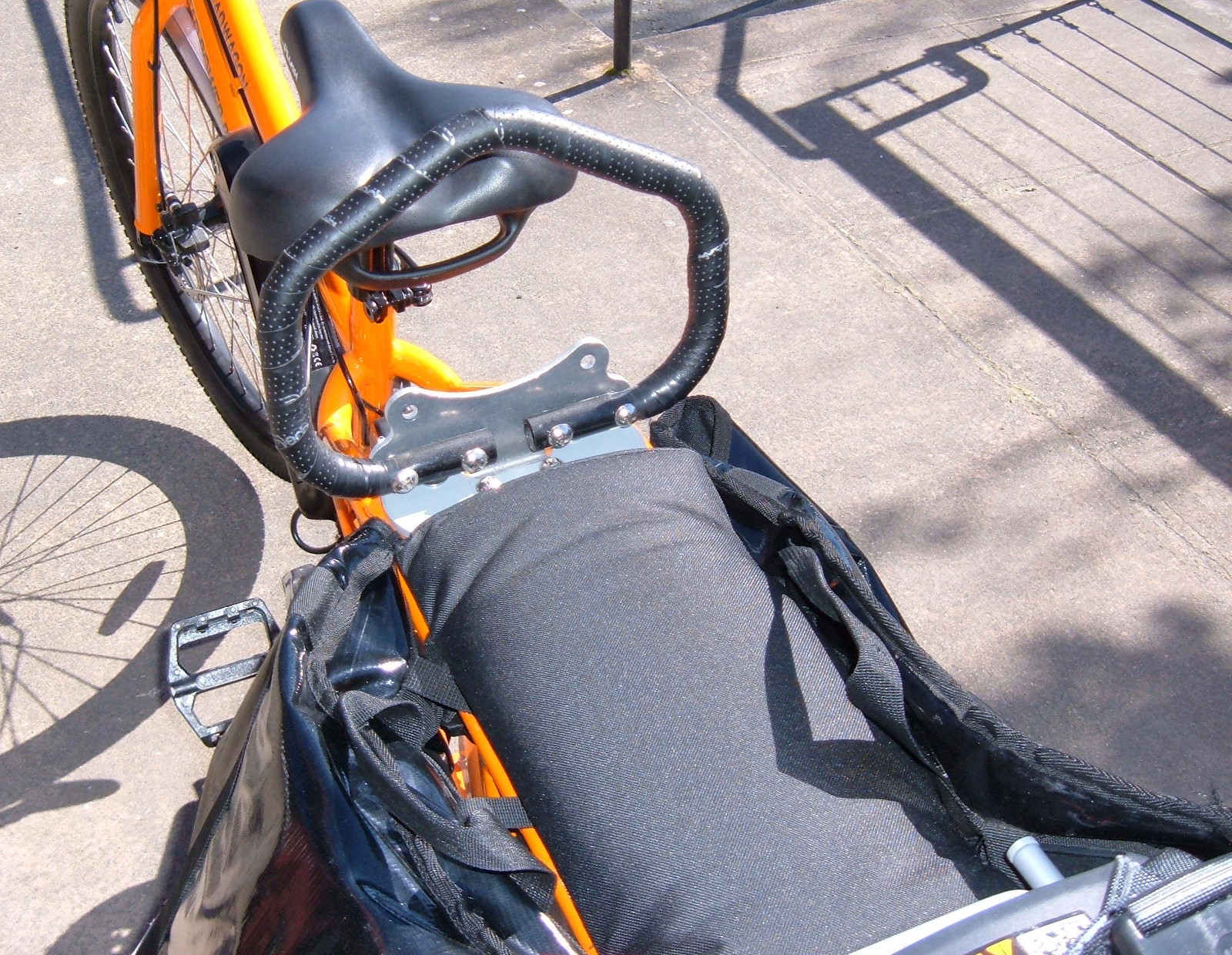
One of their accessories is called the “caboose.” It can fold up to form a cage for things, or it can (as in this case) be laid flat. This is perfect for your runs to FedEx or UPS to pick up boxes, or just to go get a stack of pizzas for lunch.
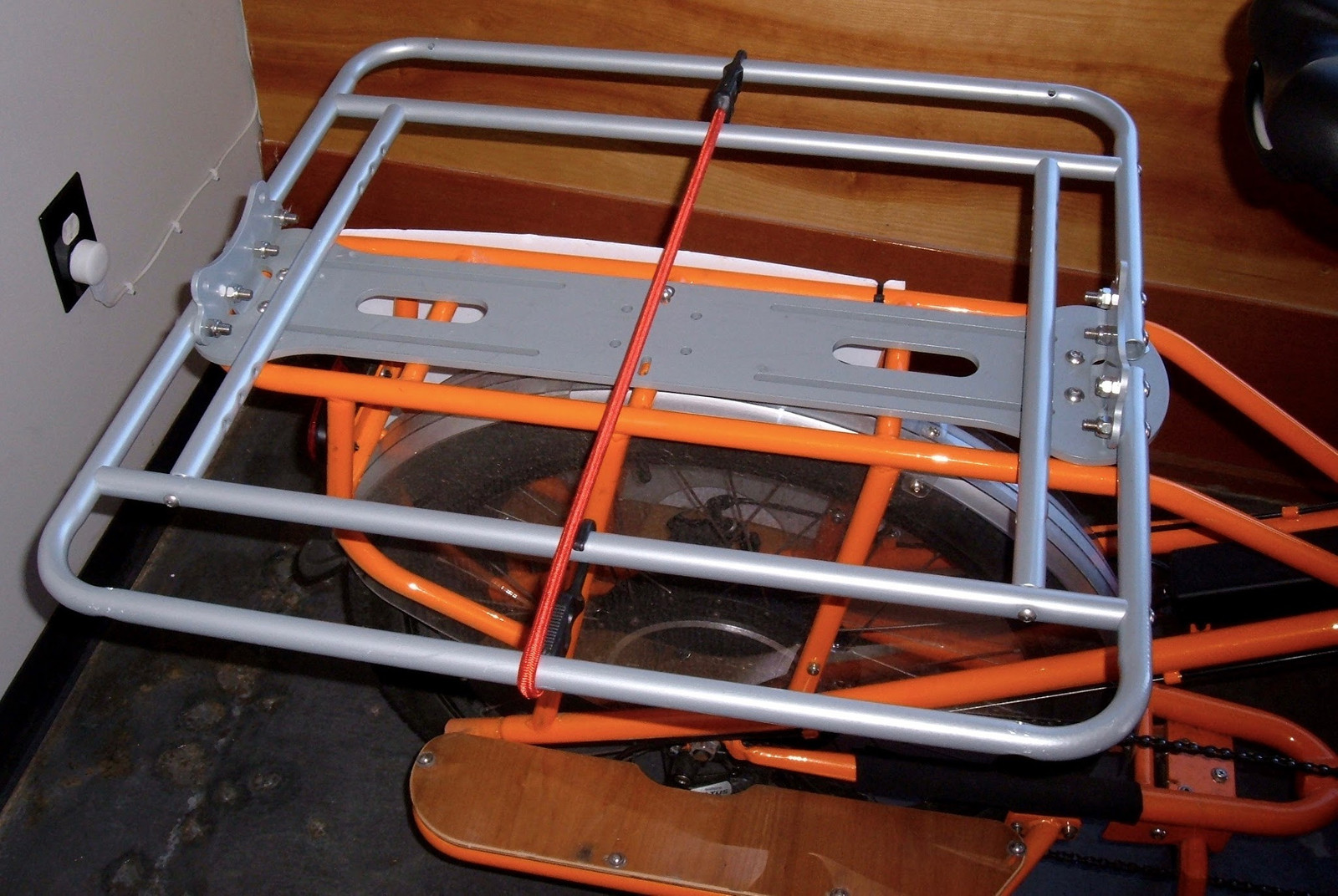
The frames are also have a pair of mounting points on the front for a cargo basket. As of the time of my test ride, Rad Power didn’t have any in stock, but you can mount a front basket to the frame, should you choose to do so.

If you want to carry it, you can probably find a way to do so on this bike. It’s really well set up.
Tweaks I’d Make
I could absolutely use this as a daily driver ebike. However, there are a few changes I’d make.
- Add a bar end mirror. I’ve been riding with these for years, and I feel utterly information-free without one.
- Replace the stock tubes with thorn resistant tubes and sealant. This bike doesn’t come with those features stock, and I hate flats.
- More headlights. I ride at night a lot, and I’m not sure the stock headlight would be sufficient for my preferred speed.
That’s really it. As is, it’s very nearly perfect, and the stuff I’d change is incredibly minor.
How Much Attention Does It Get?
Lots.
It’s an incredibly brilliant orange, and it clearly isn’t a “regular bicycle” - it’s longer, and on closer inspection, it has a battery pack that most bikes don’t.
I had multiple people ask me about it while I was taking photos, and seeing a few other people coming back on test rides, it really, really stands out on a trail.
This is not a bike you can be subtle on. If you just want to get where you’re going and not be bothered by anyone, that might be a challenge on this bike.
On the other hand, if you’re willing to be an “electric cargo bike ambassador,” show off what you can haul without a car, and take a few minutes on a regular basis to answer people’s questions - this bike will help you very nicely!
Some people will consider this level of attention getting a feature, some will consider it a flaw. Personally, I think it’s awesome - I love showing people electric bikes and letting them try one out.
Conclusions
I went into the test ride hoping to find a decent electric cargo bike and a good value. $1600. How good can it be for that price? Most cargo bikes sell for more than that without a motor!
I didn’t find a decent electric cargo bike. Instead, I found an excellent electric bike. I could replace my commuter with this, have the same performance and hill climbing, and add significantly more cargo space and kid hauling capability.
Don’t think that just because it’s a long tail cargo bike, it’s a bad bike to ride around. It’s not. It’s certainly a bit more relaxed handling than some other bikes, but I would easily ride this around as my only bike.
It has everything that matters, and doesn’t waste money on things that don’t.
I have no idea how Rad Power has managed this good of a bike for this little money, but they have. And it’s damned impressive.
If you’re anywhere around Seattle, and are even faintly interested in an electric bike - go test ride one.
And if you aren’t around Seattle, and are interested in an electric bike for all purposes? Order this one. Trust me. It’s that good.
Should you buy this bike?
Are you planning to do most of your riding on streets, bike trails, or something that resembles streets or reasonable trails?
Then, yes, you should buy this bike. Even if you don’t want the cargo aspects. It’s just that good, and you’ll probably want the cargo hauling eventually.
With the $200 shipping added on (though if you’re local, just go pick it up from their shop) and some accessories, it still comes in under $2000 - that’s a quarter the cost of an XtraCycle that will do the exact same thing.
Seriously. It really is that good.
If you do happen to pick one up, feel free to list me as a referrer - just list “Russell Graves/Syonyk” as the referrer. I have no idea what will happen since I don’t (yet) own one, but if you don’t have anyone else to list, go ahead & let them know I sent you!
If you own one, how have you been liking it? Are you considering purchasing one? Let me know below in the comments!
Comments
Comments are handled on my Discourse forum - you'll need to create an account there to post comments.If you've found this post useful, insightful, or informative, why not support me on Ko-fi? And if you'd like to be notified of new posts (I post every two weeks), you can follow my blog via email! Of course, if you like RSS, I support that too.

